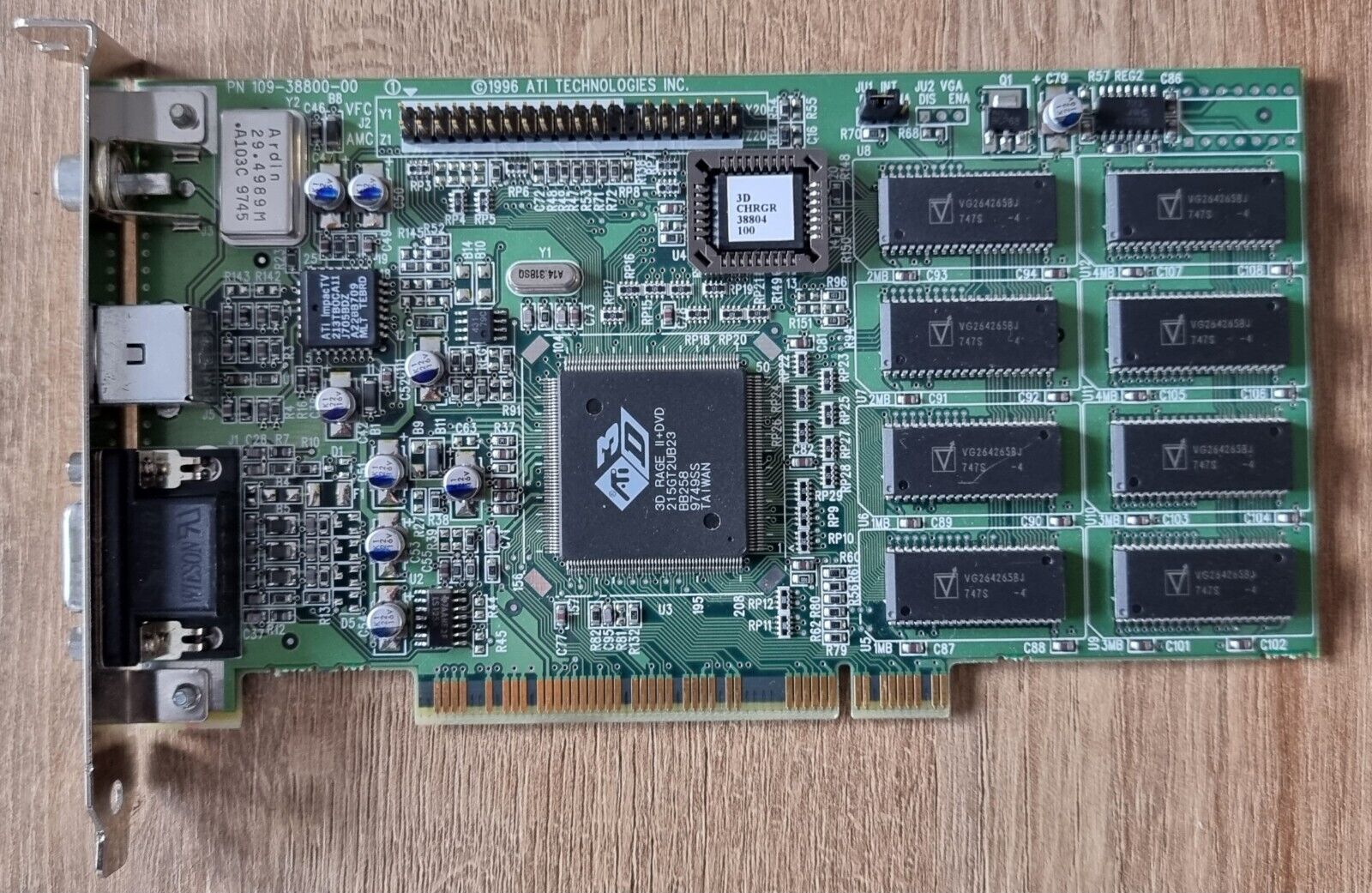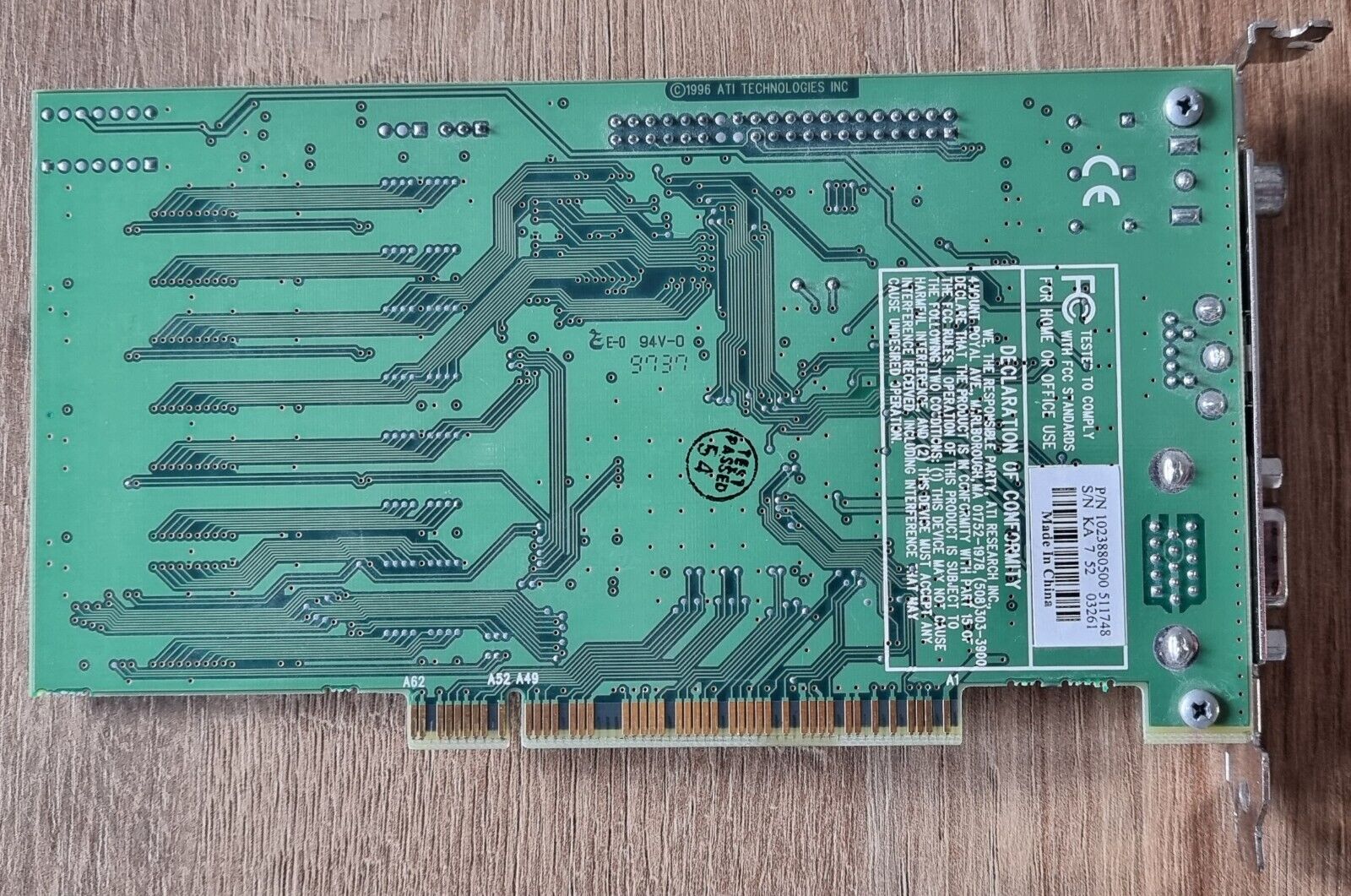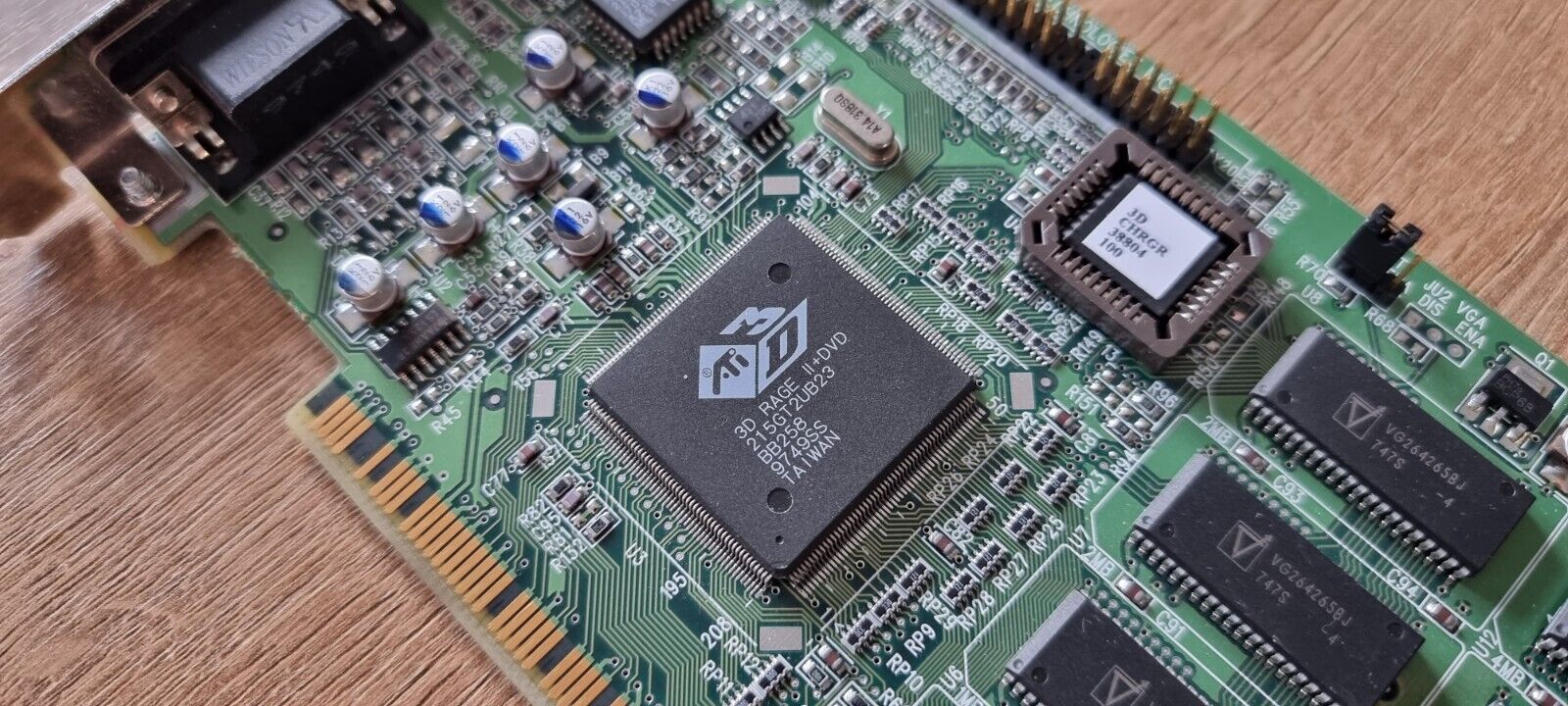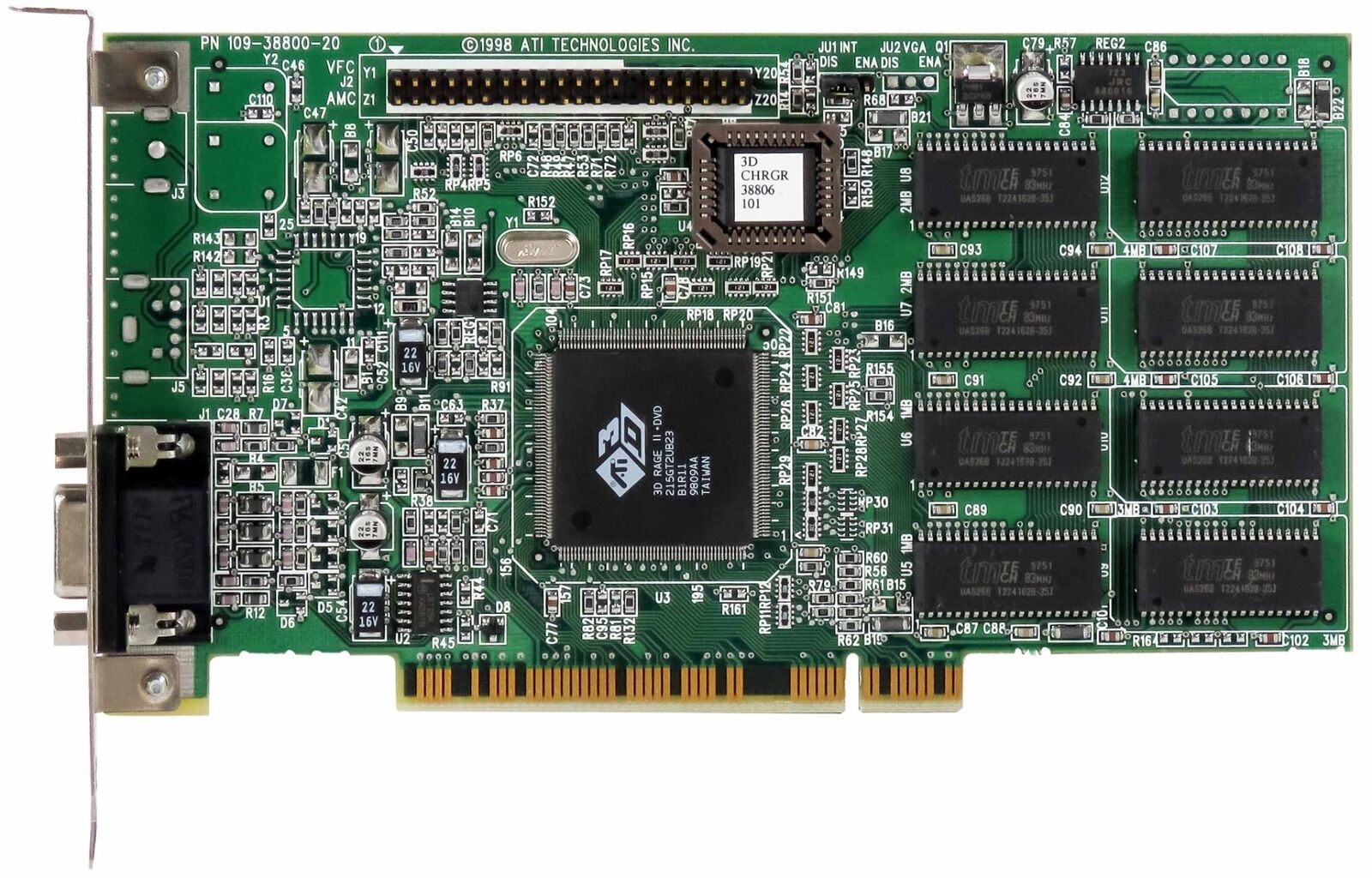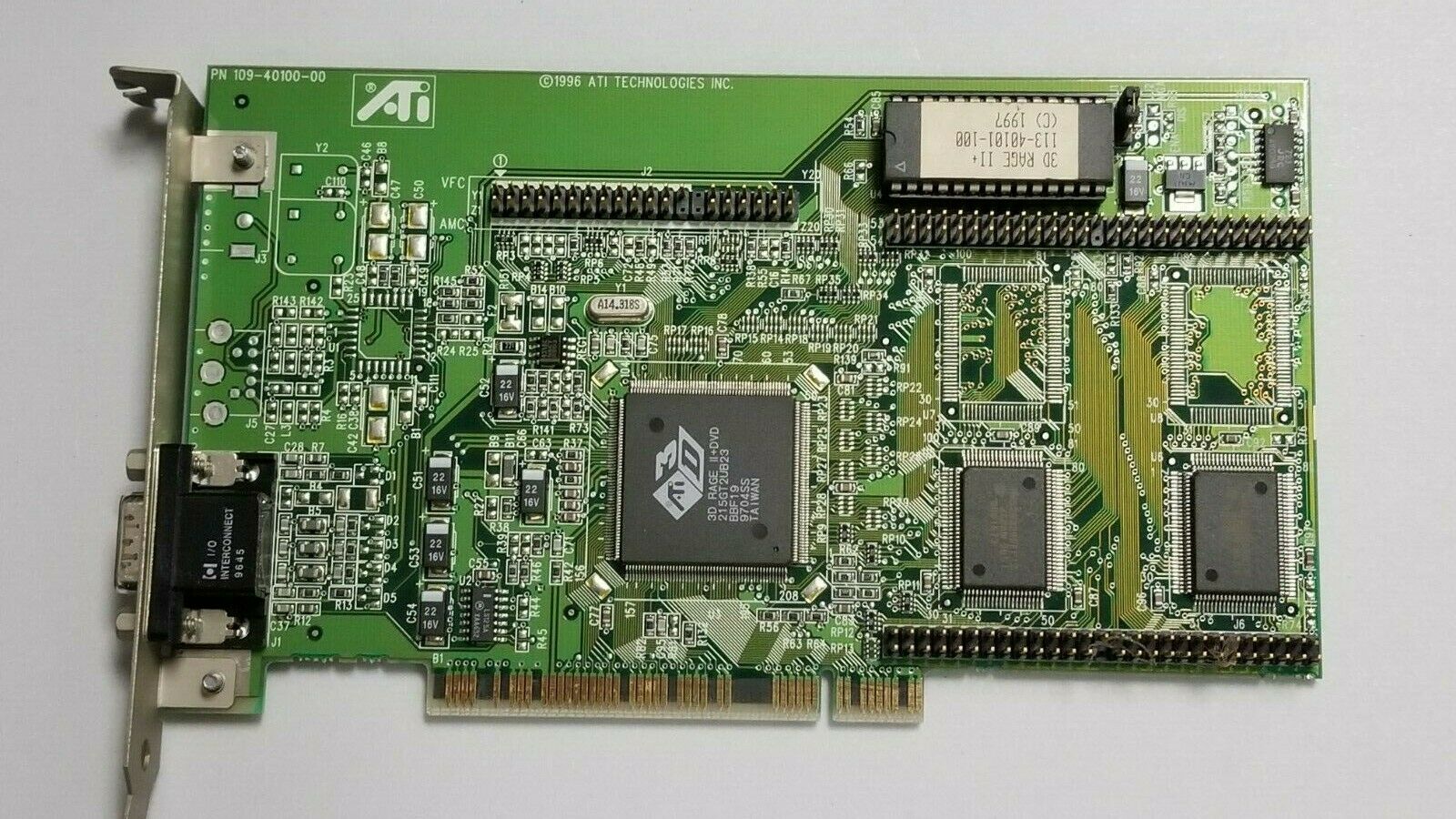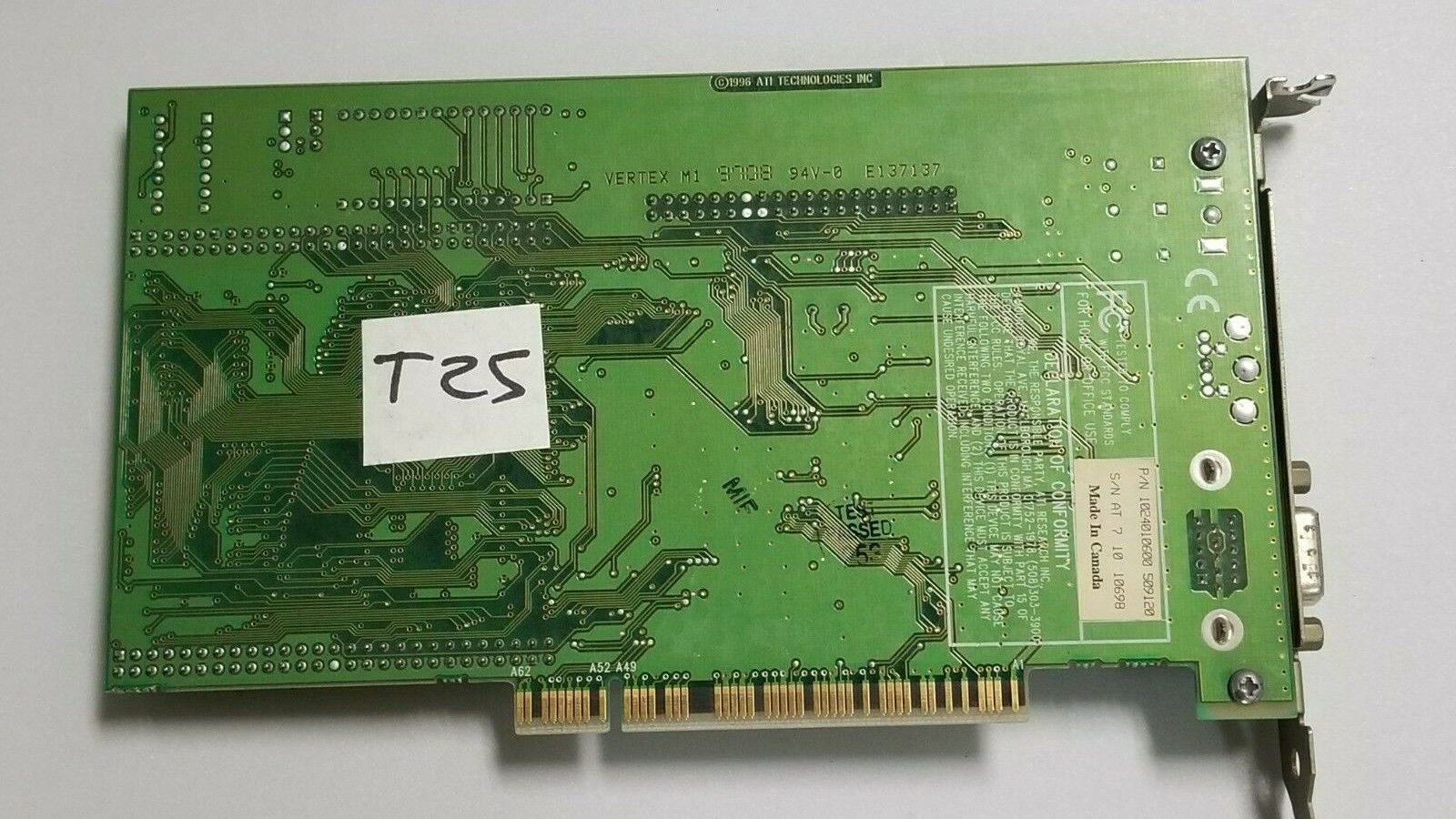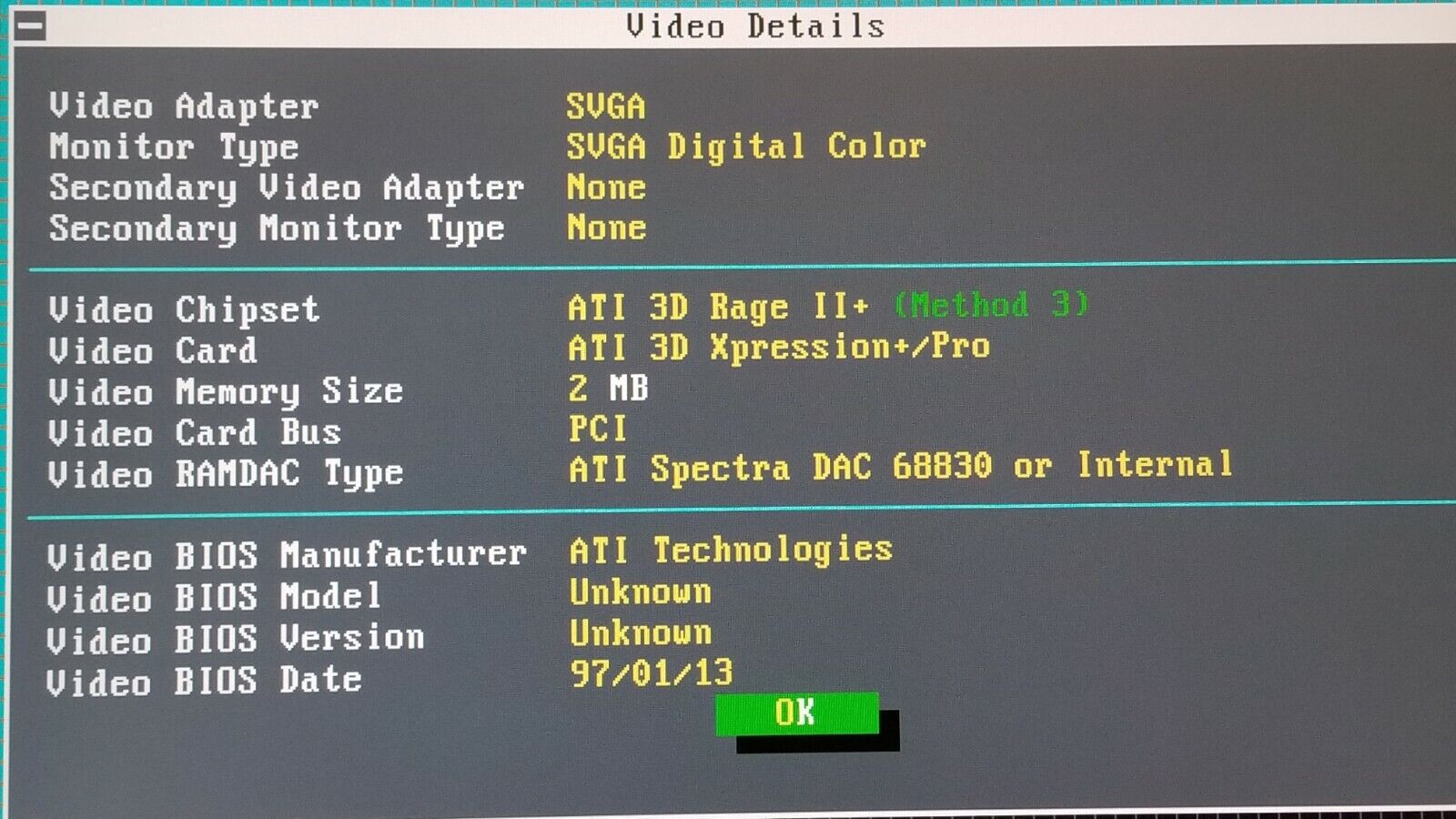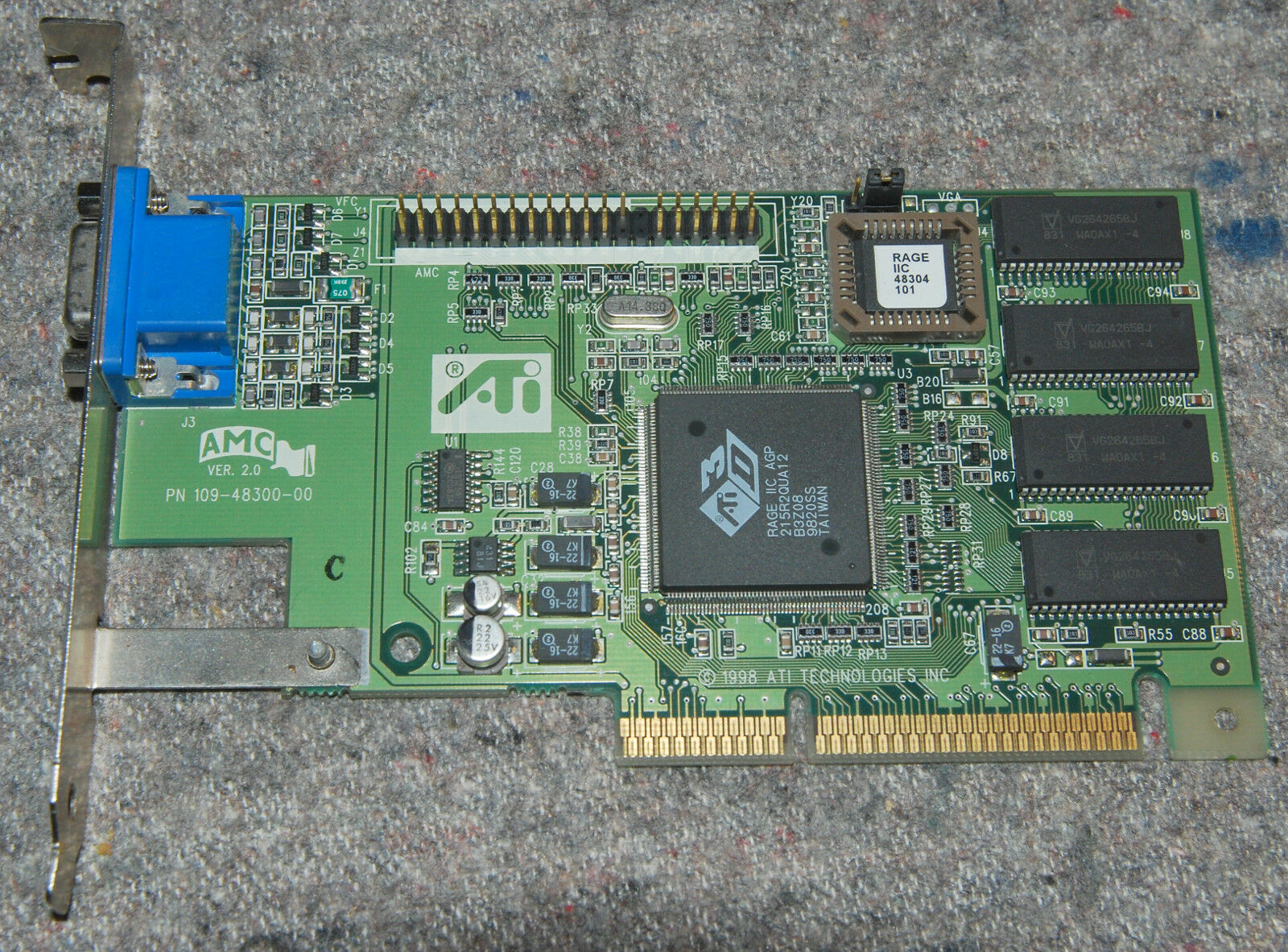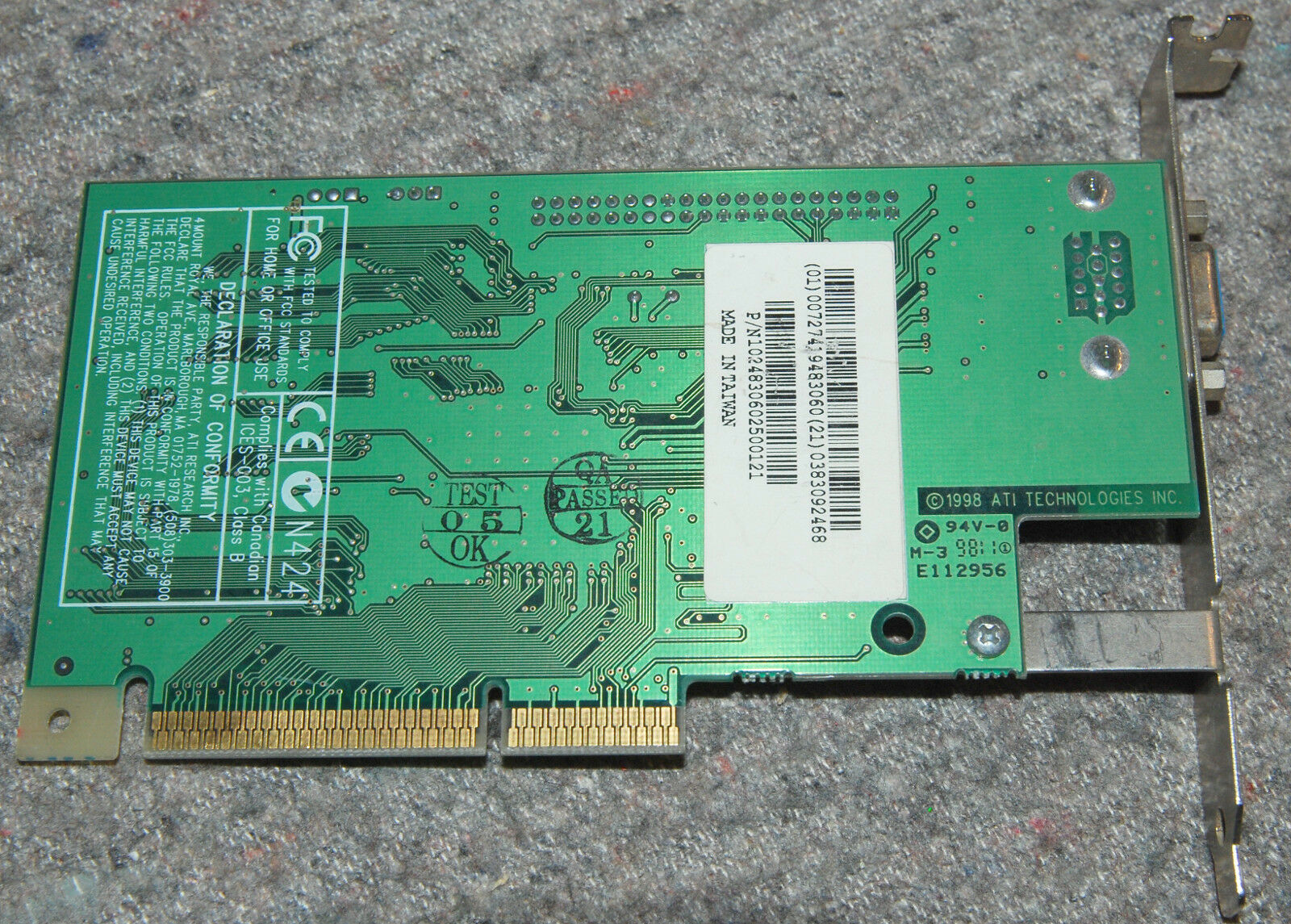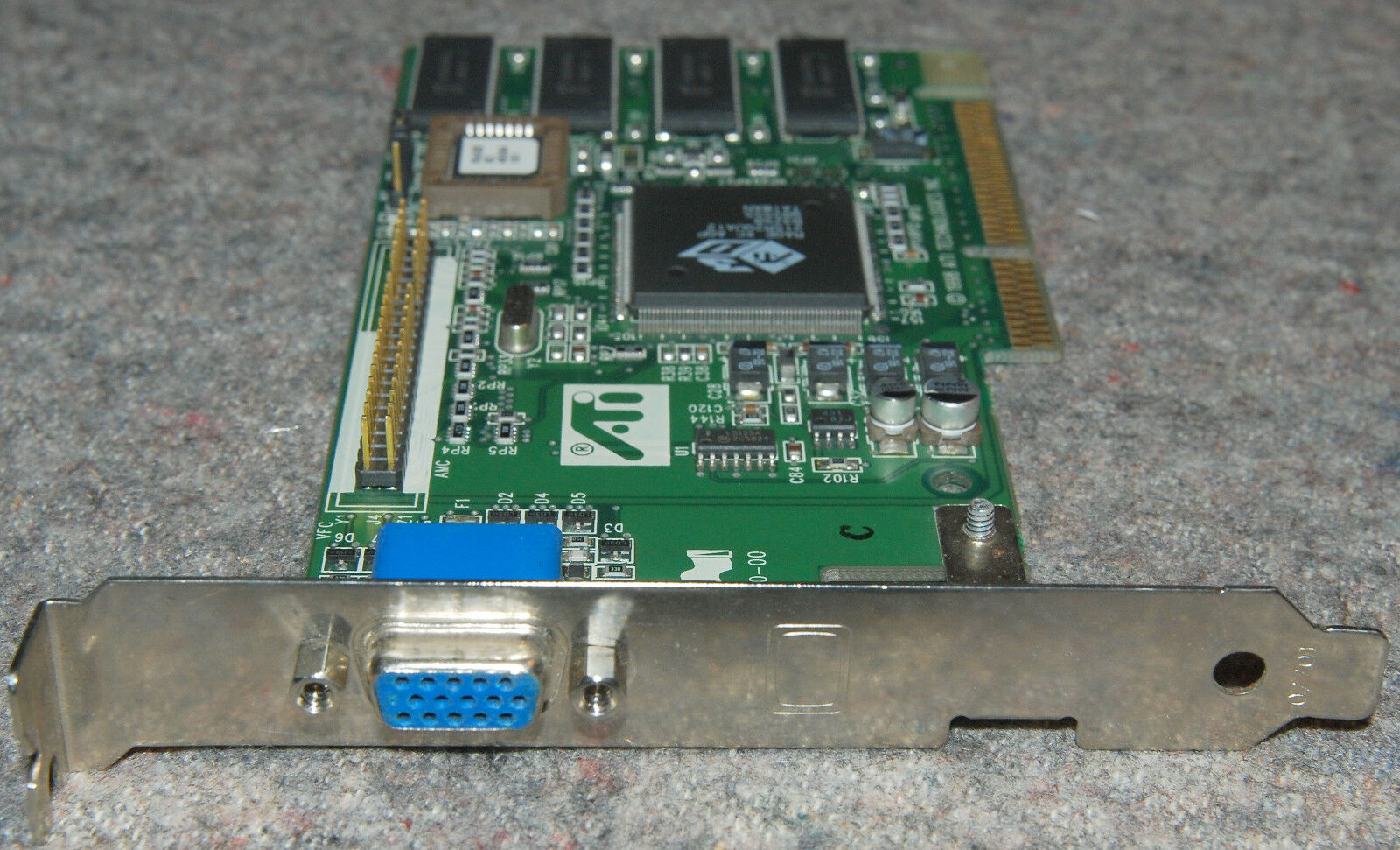 S3 Trio Series (1994-1998)
S3 Trio Series (1994-1998)
S3 Trio64 (1994)
Summary
| Launched | 1994 or 1995? | VESA Support | Yes, VESA VBE 2.0 in BIOS, VESA Advanced Feature Connector (VAFC) |
| Bus Type | PCI v2.1 or VESA Local Bus | API Support | DirectX 5.0, BRender, RenderWare, and OpenGL |
| Chipset | Trio64 (86C764) or Trio32 (86C732) | Found on Cards | Diamond Stealth 64 VLB DRAM A-Trend ATC-2125 Paradise Bahamas 64/64VL |
| Core Clock | ? MHz | ||
| Memory | 1 MB, 2 MB or 4 MB of FPM or EDO DRAM | ||
| Memory Speed | 40 MHz - 66 MHz | ||
| RAMDAC | 24-bit TrueColor (integrated) | Competitors | S3 ViRGE/GX SiS 6326 nVidia RiVA 128 3d Labs Permedia 2 Rendition Verite 2100 Number Nine Ticket to Ride Matrox Millennium G200 Matrox Mystique 220 |
| RAMDAC Speed | 135 MHz - 170 MHz |
Introduction
The Trio range of integrated graphics accelerator chipsets began life in the form of the Trio64 and Trio64V+ in 1994 and mid-1995 respectively - they took their earlier Vision864 and Vision868 chips respectively, and integrated a RAMDAC onto the die. These new chipsets used a 64-bit data path for memory access. Trio32 was also introduced in 1995 as a cut-down cost-effective version of the original Trio64, with its 32-bit wide memory access path and memory limited to 2 MB.
The Trio64V2 followed two years later in 1996. It came in two forms: Trio64V2/DX and Trio64V2/GX, with the former still using DRAM memory and the letter able to use the newer, faster SDRAM and SGRAM technology. Both the DX and GX added vertical bilinear filtering, a 170 MHz RAMDAC, and up to 83 Hz vertical refresh rate at 1280 x 1024 (up from 72 Hz on the Trio64 and Trio64V+) or 60 Hz refresh rate at 1600 x 1200 non-interlaced.
A summary of the Trio range is listed below:
- Trio64 - first version of the chip, launched in late 1994. PCI or VESA Local Bus only.
- Trio64V+ -
- Trio32 - cost-effective variant, with 1 MB or 2 MB DRAM on a 32-bit memory path. Same 135 MHz RAMDAC as Trio64/64V+.
- Trio64V2/DX - Added bilinear filtering, faster RAMDAC, higher resolution support over Trio64/64V+. Uses DRAM memory.
- Trio64V2/GX - As V2/DX but uses faster SDRAM or SGRAM memory.
- Trio3D -
- Trio3D/2X -
Here's a comparison table of the Trio range compared to the Vision range that came before it:
| Vision864 | Vision868 | Trio64 / 64V+ | Trio32 | Trio64V2/DX / V2/GX | Trio3D | Trio3D/2X | |
|---|---|---|---|---|---|---|---|
| Release Date | Feb 1994 | Feb 1994 | 1994/1995 | 1994 | 1996 | Nov 1997 | 1999 |
| Chip | 86C864 | 86C868 | 86C764 | 86C732 | 86C775 | 86C365 | 86C368 |
| Bus | VLB/PCI | VLB/PCI | VLB/PCI | PCI | PCI | PCI, AGP 1x | PCI, AGP 2x |
| Core Clock | 60 MHz | 60 MHz | 135 MHz | 135 MHz | 170 MHz | 230 MHz | 230 MHz |
| Memory Bus Width | 64-bit | 64-bit | 64-bit | 32-bit | 64-bit | 64-bit | 64-bit |
| Memory Sizes | 1, 2 or 4 MB | 1, 2 or 4 MB | 1, 2 or 4 MB | 1 or 2 MB | 1, 2 or 4 MB | 4 MB | 4 or 8 MB |
| Memory Clock | 50 MHz | 50 MHz | 55 - 70 MHz | 55 - 60 MHz | 60 MHz | 90 - 100 MHz | 90 - 100 MHz |
| Memory Bandwidth | 240 MB/s | 240 MB/s | ? MB/s | ? MB/s | 480/528 MB/s | 800 MB/s | 800 MB/s |
| # Pixel Shaders | - | - | - | - | - | 1 | 1 |
| # Vertex Shaders | - | - | - | - | - | 0 | 0 |
| # Texture Mapping Units (TMUs) | - | - | - | - | - | 1 | 1 |
| # Raster Operation Pipelines (ROPs) | - | - | - | - | - | ||
| Cards that Used it |
New 3D features in the 3D Rage II included a 16-bit Z-buffer and support for 4-bit and 8-bit palletised textures, but like the Matrox MGA Millennium, it did not have bilinear filtering or alpha blending capabilities.
The integrated RAMDAC ran at 170 MHz but ATi were also able to screen for qualification at 200 MHz, which they offered to OEM customers as an option. At launch, ATi claimed the 3D Rage II had 20% better 2D performance and twice the 3D performance of the earlier 3D Rage chip, with up to 26 MPixels/sec. Not having their own fabrication plant, ATi used a number of external chip fabricators for the 3D Rage II, including SGS Thomson, NEC and UMC, and later on, TSMC.
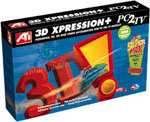 The first graphics card from ATi to feature the new 3D Rage II chip was the Xpression+ PC2TV (model number 109-37900-00), which launched at the same time as the chip in September 1996 with a street price of $219 in 2 MB form. It was bundled with special versions of MechWarrior 2 and WipeOut, and a few other apps aligned with the TV and video aspects of the card. This card also featured ATI's home-grown NTSC/PAL encoder chip called ImpacTV. This 28-pin PLCC chip communicated with the 3D Rage II using the ATI Multimedia Channel (AMC) interface. Its core ran at 55 MHz with the EDO memory ran at 60 MHz. Another version of Xpression+ PC2TV came with the faster SDRAM type of memory that ran at 70 MHz. The next card to arrive with a 3D Rage II chip was Xpression+, also in 1996 - basically the same but without the ImpacTV, the same core clock (aka pixel clock) but it had super-fast SGRAM memory that ran at 66 MHz. It also came bundled with MechWarrior 2. These cards were the only ones to use the first iteration of the 3D Rage II chip.
The first graphics card from ATi to feature the new 3D Rage II chip was the Xpression+ PC2TV (model number 109-37900-00), which launched at the same time as the chip in September 1996 with a street price of $219 in 2 MB form. It was bundled with special versions of MechWarrior 2 and WipeOut, and a few other apps aligned with the TV and video aspects of the card. This card also featured ATI's home-grown NTSC/PAL encoder chip called ImpacTV. This 28-pin PLCC chip communicated with the 3D Rage II using the ATI Multimedia Channel (AMC) interface. Its core ran at 55 MHz with the EDO memory ran at 60 MHz. Another version of Xpression+ PC2TV came with the faster SDRAM type of memory that ran at 70 MHz. The next card to arrive with a 3D Rage II chip was Xpression+, also in 1996 - basically the same but without the ImpacTV, the same core clock (aka pixel clock) but it had super-fast SGRAM memory that ran at 66 MHz. It also came bundled with MechWarrior 2. These cards were the only ones to use the first iteration of the 3D Rage II chip.
3D Jargon Busting
Alpha blending is a way of allowing one object to show through another to give the illusion of transparency.Anti-aliasing helps clean up the jagged edge at the seams between mapped textures by using transitional pixels of blended colours.
Bilinear filtering smooths textures in a scene to lessen the blocky effect.
Double buffering increases the number of frames drawn per second. As one scene is being rendered in the front buffer of the graphics card, the next scene is sent to the back buffer for processing.
Flat shading is the most basic shading technique, where a triangle is painted without reference to adjacent triangles.
MIP mapping uses several different resolutions of an object's texture as the object moves closer or further away. These textures can then be filtered together and applied to the scene to enhance the illusion of depth.
Specular lighting shows the reflection from a light source on an object's surface.
Texture mapping applies a bitmapped texture image to the objects in a scene - the bricks on a wall, for example.
Z-buffering is a method of tracking parts of objects that are not in view and should not be drawn. This is done by plotting each object's position relative to the viewer and to other objects according to its x, y, and z coordinates.
The 3D Rage II+DVD arrived in February 1997. It still had the same 55 MHz core and memory speeds were either 60 or 66 MHz . These cards got an enhanced RAMDAC that now ran at 200 MHz and MPEG-2 (DVD) video acceleration. It was designed to run best with 83 MHz SGRAM memory with its block write feature, but also came on cards designed for the older EDO DRAM as a cheaper option.
3D features of the +DVD include perspectively correct texturing, video texturing, Gouraud shading, 16-bit Z-buffering, bilinear and trilinear texture filtering, Direct3D texture lighting, alpha blending, and fog.
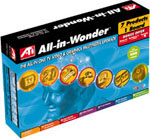 The first card to use the 3D Rage II+DVD was ATi's All-in-Wonder with a list price of $329 and a street price of $290. The All-in-Wonder card won PC Magazine's Editor's Choice in June 1997. It came with analogue TV out, built-in video capture capabilities and an onboard TV tuner. You could opt for a 2MB EDO card upgradable to 4 MB, or 4 MB EDO out of the box, both of which supported up to 1600 x 1200 non-interlaced resolution, or 1280 x 1024 in 16.7 million colours on the 4 MB version. Refresh rates as high as 200 Hz were possible at some resolutions.
The first card to use the 3D Rage II+DVD was ATi's All-in-Wonder with a list price of $329 and a street price of $290. The All-in-Wonder card won PC Magazine's Editor's Choice in June 1997. It came with analogue TV out, built-in video capture capabilities and an onboard TV tuner. You could opt for a 2MB EDO card upgradable to 4 MB, or 4 MB EDO out of the box, both of which supported up to 1600 x 1200 non-interlaced resolution, or 1280 x 1024 in 16.7 million colours on the 4 MB version. Refresh rates as high as 200 Hz were possible at some resolutions.
The 3D Rage IIc was the last of the 3D Rage II series, coming out about a year after the first 3D Rage II, in April 1997. Like the 3D Rage Pro that launched alongside it, it added support for the then-new AGP bus. It was the budget offering, performing similarly to the S3 Trio3D or S3 ViRGE/GX2. The 3D Charger was the first card available to use this chip and was available with either 4 MB or 8 MB EDO memory for the PCI bus, or 8 MB EDO only for the AGP bus (I believe this was ATI's first AGP card).
The 3D Rage and 3D Rage II series all support DirectX 5.0, but the 3D Rage II also came with drivers for Argonaut BRender and Criterion RenderWare APIs. OpenGL 1.0 support was also available via software drivers only (no hardware OpenGL).
Supported Graphics Modes
The original 3D Rage II chip supports resolutions up to 1600 x 1200. The table below outlines the vertical refresh rates available at each resolution:
| Resolution | 640x 480 | 800x 600 | 1024x 768 | 1152x 864 | 1280x 1024 | 1600x 1200 |
| 256 colors | 60-200 | 60-200 | 60-150 | 60-100 | 60-85 | 60 |
| 65K colors | 60-200 | 60-160 | 60-140 | 60-100 | 60-85** | 60** |
| 16.7M colors | 60-200 | 60-160 | 60-120 ** | 60-85** | 60-75** | - |
The 3D Rage II+DVD also supports resolutions up to 1600 x 1200 but with its 200 MHz RAMDAC it could achieve higher vertical refresh rates.
2D Display Modes & Refresh Rates
|
3D Display Modes
|
|||||||||||||||||||||||||||||||||||||||||||||||||||||||||||||||||||||||||||||||||||||||||||||||||||||||||||||||||||||||||||||||||||||||||||||||||||||||||||||||||||||||||||||||||||||||||||||||||||||||||||||||||||||||||||||||||||||||||
Memory
All chips in the earlier 3D Rage series were designed with a 64-bit memory pathway, but the 3D Rage II bettered its older brother with its support for three different memory types that were prevalent at the time: the original EDO DRAM that the earlier 3D Rage could only use, but also SGRAM and SDRAM which ran at up to 83 MHz, in capacities from 2 MB up to 8 MB. If SGRAM or SDRAM were used, memory bandwidth rose from 320 MB/sec to 664 MB/sec.
In summary, these are the memory types and their speeds used by the 3D Rage II series:
- 3D Rage II - EDO (60 MHz), SDRAM (70 MHz) and SGRAM (66 MHz)
- 3D Rage II+DVD - EDO (60 MHz) and SGRAM (66 MHz or 83 MHz)
- 3D Rage IIc - EDO (60 MHz) and SDRAM (83 MHz)
.jpg) All ATI 3D Rage II cards max out at 4 MB on the card itself. On some cards (3D Xpression+, 3D Rage II), the 8 MB (or 6 MB on 2MB boards) is reached through the installation of a 2 MB or 4 MB SGRAM memory expansion daughterboard (Part # 109-34600-10), so if you're looking for a 6 or 8 MB card they don't exist - you need a card and the memory expansion daughterboard to get the full capacity.
All ATI 3D Rage II cards max out at 4 MB on the card itself. On some cards (3D Xpression+, 3D Rage II), the 8 MB (or 6 MB on 2MB boards) is reached through the installation of a 2 MB or 4 MB SGRAM memory expansion daughterboard (Part # 109-34600-10), so if you're looking for a 6 or 8 MB card they don't exist - you need a card and the memory expansion daughterboard to get the full capacity.
Others like the 3D Xpression+ PC2TV and some 3D Charger cards came with SOJ sockets to expand the onboard memory.
Cards based on the 3D Rage IIC chip were not expandable, since these were sold as the budget offering.
Bear in mind also that the memory on the ATI 3D Rage II series is split between 2D video [frame buffer] memory and 3D memory for textures, so more memory doesn't necessarily mean higher resolutions or colour depths in Windows.
Ports
In addition to the standard 15-pin DSUB for analogue video output, some 3D Rage II cards also supported TV-out via S-Video and composite connectors. Most also include the AMC (ATi Multimedia Channel) interface port. For those cards that provided audio/video inputs, these also came in the form of S-Video and Composite connectors on the backplate.
Switches
The ATI Rage II series are fully Plug & Play, so no hardware configuration / jumpers / DIP switches need to be set.
The Video BIOS
Cards that used the 3D Rage II series had many versions of video BIOS, most of which are shown in the table below:
| Chip Variant | BIOS | Marking on Chip | Card |
|---|---|---|---|
| 3D Rage II | 113-37101-114 | "PCI Mach64-VR" | ATi 3D Xclaim (109-37100-00) |
| 3D Rage II | 113-37902-102 | "RAGEII NTSC" | 4MB ATi Xpression PC2TV (109-37900-00) |
| 3D Rage II | 113-37906-100 | "RAGEII NTSC". | 4MB ATi Xpression PC2TV (109-37900-00) |
| 3D Rage II | 113-38204-101 | "PCI Mach64-GT". | ATi 3D Xpression+ (109-38200-00) |
| 3D Rage II | 113-38204-102 | "PCI Mach64 GT". | ATi 3D Xpression+ (109-38200-00) |
| 3D Rage II | 113-38500-100 | "PCI Mach64 GT". | ATi 3D Xpression+ PC2TV (109-38500-00) |
| 3D Rage II+ | 113-40109-100 | "RAGE II+". | 2MB ATi 3D Rage II (109-40100-00) |
| 3D Rage II+DVD | 113-37913-103 | "RAGEII+ PAL". | 4MB ATi Xpression PC2TV ( 109-37900-10) |
| 3D Rage II+DVD | 113-37922-100 | "RAGEII+ NTSC". | 4MB ATi Xpression PC2TV ( 109-37900-10) |
| 3D Rage II+DVD | 113-37924-100 | "RAGEII PAL". | 4MB ATi Xpression PC2TV (109-37900-10) |
| 3D Rage II+DVD | 113-38601-101 | "ALL IN WONDER" | 4MB ATi All-in-Wonder (109-38600-00) |
| 3D Rage II+DVD | 113-38604-100 | "ALL IN WONDER" | 4MB ATi All-in-Wonder (109-38600-00) |
| 3D Rage II+DVD | 113-38801-101 | "GTB" | 2MB ATi 3D Charger (109-38800-00) |
| 3D Rage II+DVD | 113-38801-101 | "113 38801 101" | 4MB ATi 3D Charger (109-38800-00) |
| 3D Rage II+DVD | 113-38802-101 | "3D CHRGR" | 4MB ATi 3D Charger (109-38800-00) |
| 3D Rage II+DVD | 113-38804-100 | "3D CHRGR" | 4MB ATi 3D Charger (109-38800-00) |
| 3D Rage II+DVD | 113-38806-100 | "3D CHRGR" | 4MB ATi 3D Charger (109-38800-00) |
| 3D Rage II+DVD | 113-38806-101 | "3D CHRGR" | 4MB ATi 3D Charger (109-38800-10) |
| 3D Rage II+DVD | 113-38806-101 | "3D CHRGR" | 4MB ATi 3D Charger ( 109-38800-20) |
| 3D Rage II+DVD | 113-40101-100 | "3D RAGE II+" | 2MB ATi 3D Rage II (109-40100-00) |
| 3D Rage II+DVD | 113-40103-101 | "RAGE II+ NTSC" | 4MB ATi 3D Rage II (109-40100-00) |
| 3D Rage II+DVD | 113-40108-100 | "RAGE II+ NTSC" | 4MB ATi 3D Rage II (109-40100-00) |
| 3D Rage II+DVD | 113-40109-100 | "RAGE II+" | 2MB ATi 3D Rage II (109-40100-00) |
| 3D Rage II+DVD | 113-40110-100 | "RAGE II+" | 4MB ATi 3D Rage II (109-40100-00) |
| 3D Rage II+DVD | 113-40602-100 | "3D CHARGER" | 4MB ATi 3D Rage IIC PCI (109-40600-00) |
| 3D Rage II+DVD | 113-40603-101 | ATi 3D Charger (109-38800-00) | |
| 3D Rage IIc | 40606 102 | "RAGE2C PCI" | 2MB ATi 3D Rage IIC PCI (109-40600-10) |
| 3D Rage IIc | 48302 101 | "RAGE IIC | 4MB ATi Rage IIC AGP (109-48300-00) |
| 3D Rage IIc | 48303 101 | "RAGE IIC | 4MB ATi Rage IIC AGP (109-48300-00) |
| 3D Rage IIc | 48304 101 | "RAGE IIC | 4MB ATi Rage IIC AGP (109-48300-00) |
| 3D Rage IIc | 48305 101 | ||
| 3D Rage IIc | 49302 100 | "RAGE IIC" | 4MB ATi Rage IIC AGP (109-49300-00) |
| 3D Rage IIc | 49302 101 | "RAGE IIC" | 4MB ATi Rage IIC AGP (109-49300-01) |
| 3D Rage IIc | 52804 100 | "RAGE IIC AGP" | 4MB ATi Rage IIC AGP (109-52800-01) |
| 3D Rage IIc | 52805 100 | "RAGE IIC AGP" | 4MB ATi Rage IIC AGP (109-52800-01) |
Upgrades and Successors
The 3D Rage II series was succeeded pretty soon, late 1997, with the 3D Rage Pro chip, which was first used on the ATI All-in-Wonder Pro and ATi Xpert@Play cards, both of which employed SGRAM memory. In 3D operations, these 3D Rage Pro cards turned out to be quite a bit slower than those using the new nVidia RiVA 128 (cards like the Diamond Viper 330 and Canopus Total3D 128V), but was faster than other rivals including the Matrox Millennium II, 3dfx Voodoo Rush, and S3 ViRGE DX and GX. Boards that had 8 MB of video memory faired even better at resolutions of 800 x 600 than at 640 x 480 with similar performance to the 3D Labs Permedia 2.
ATi was a solid proponent of the new AGP architecture, and their early AGP cards like the ones mentioned were much more full-featured in this regard, utilising much of what AGP could offer to gain a performance advantage over PCI-based rivals. The 3D Rage Pro cards used the new industry-standard SODIMM memory socket for expansion and retained the AMC connector for peripherals such as standalone TV or DVD cards.
The 3D Rage Pro also included an impressive amount of Microsoft's DirectX 6.0 Direct3D features compared to other cards at the time, plus support for OpenGL 1.1.
Reception
The ATi 3D Rage II arrived about the same time as the S3 ViRGE/GX, and both competed in the very crowded early 3D market in 1996. In most regards the ATi chip achieved higher frames per second in gaming compared to the S3, even with just 2 MB of memory onboard. With 4 MB or more, this gap would be even wider.
The 3D Rage II+[DVD] arrived in 1997, and with it a slight boost in 3D performance over the 3D Rage II, with apparently a 30% improvement in small triangle performance. Also with the + was a boost in memory speed, up from 60 MHz to 83 MHz if you had SGRAM. ATi's advertisements as the time claimed the 3D Rage II+DVD could achieve over 2x as many MPixels per second fill rate as the S3 ViRGE (the original, not the GX), and over 1.5x that of a Matrox Mystique. In reality, filtering quality on the 3D Rage II series was poor and this hit frame rates if the feature was enabled in games.
By 1997 there were other cheap 3D cards that could achieve better fps performance, such as the SiS 6326, and if you wanted the best of the best this year, you would have opted instead for a card based on the first nVidia chip, RiVA 128 with its 128-bit memory - even in PCI form it was about twice as fast as the original ATi 3D Rage II. A closer match in performance was ATi's All-in-Wonder 128.
These days if you are looking to buy one of these cards for gaming, you have two choices: PCI or AGP. If it's a PCI card, avoid all 2 MB cards and those with a 3D Rage II or 3D Rage IIC chip. Instead, aim for a full-featured 4 MB SGRAM-based 3D Rage II+DVD (check the memory is 83 MHz too), and if possible, one with a 2 MB or 4 MB memory expansion daughterboard, though these are more rare. For AGP, you have no choice as only the 3D Rage IIC cards came in AGP form. If possible get a 4 MB SDRAM one of these, which was the maximum.
Images
The cards shown in this section illustrate the various models of card with a variety of memory ICs and BIOS ICs.
Rage II 4 MB card (109-37100-00) (1996):
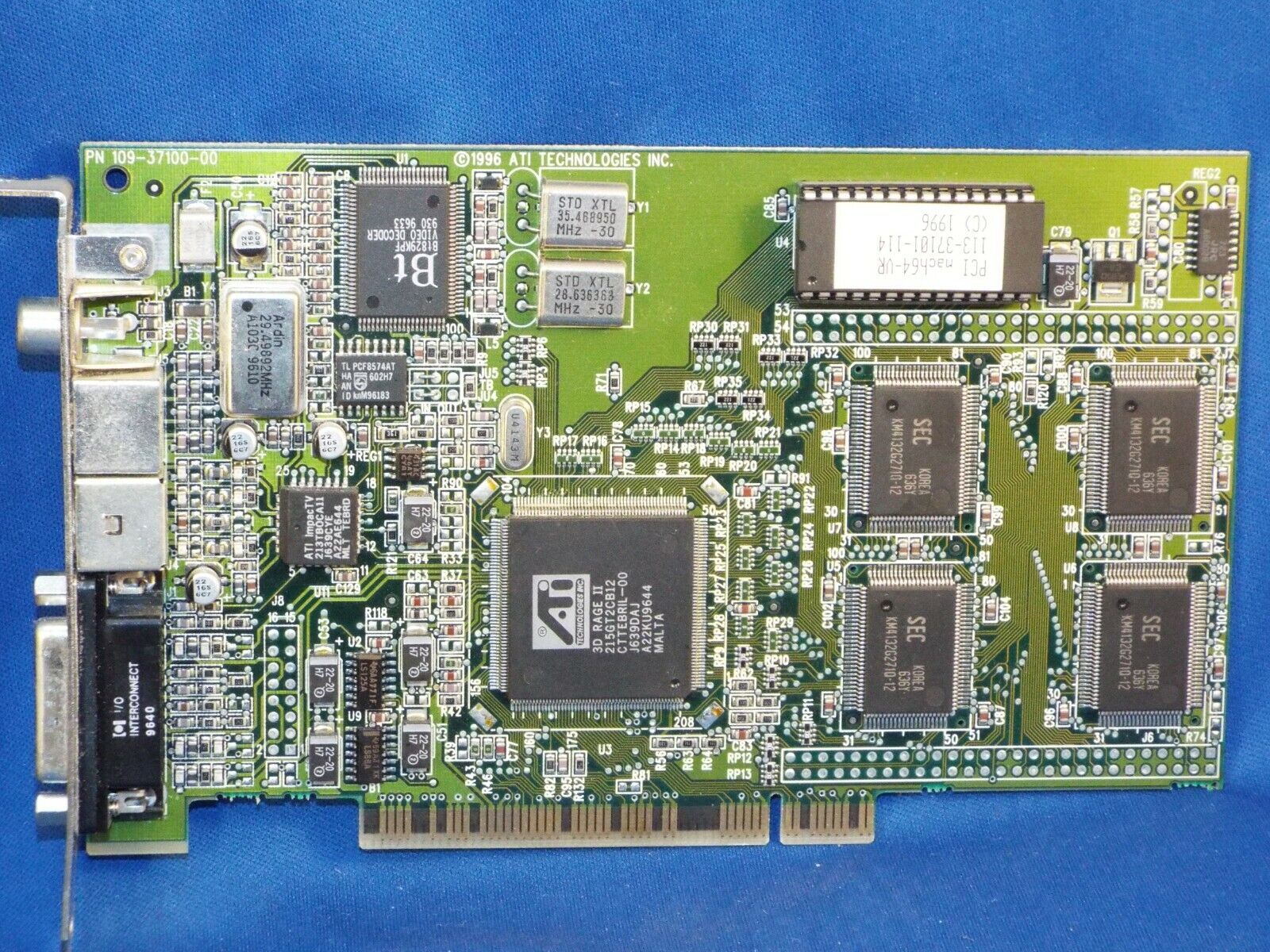 |
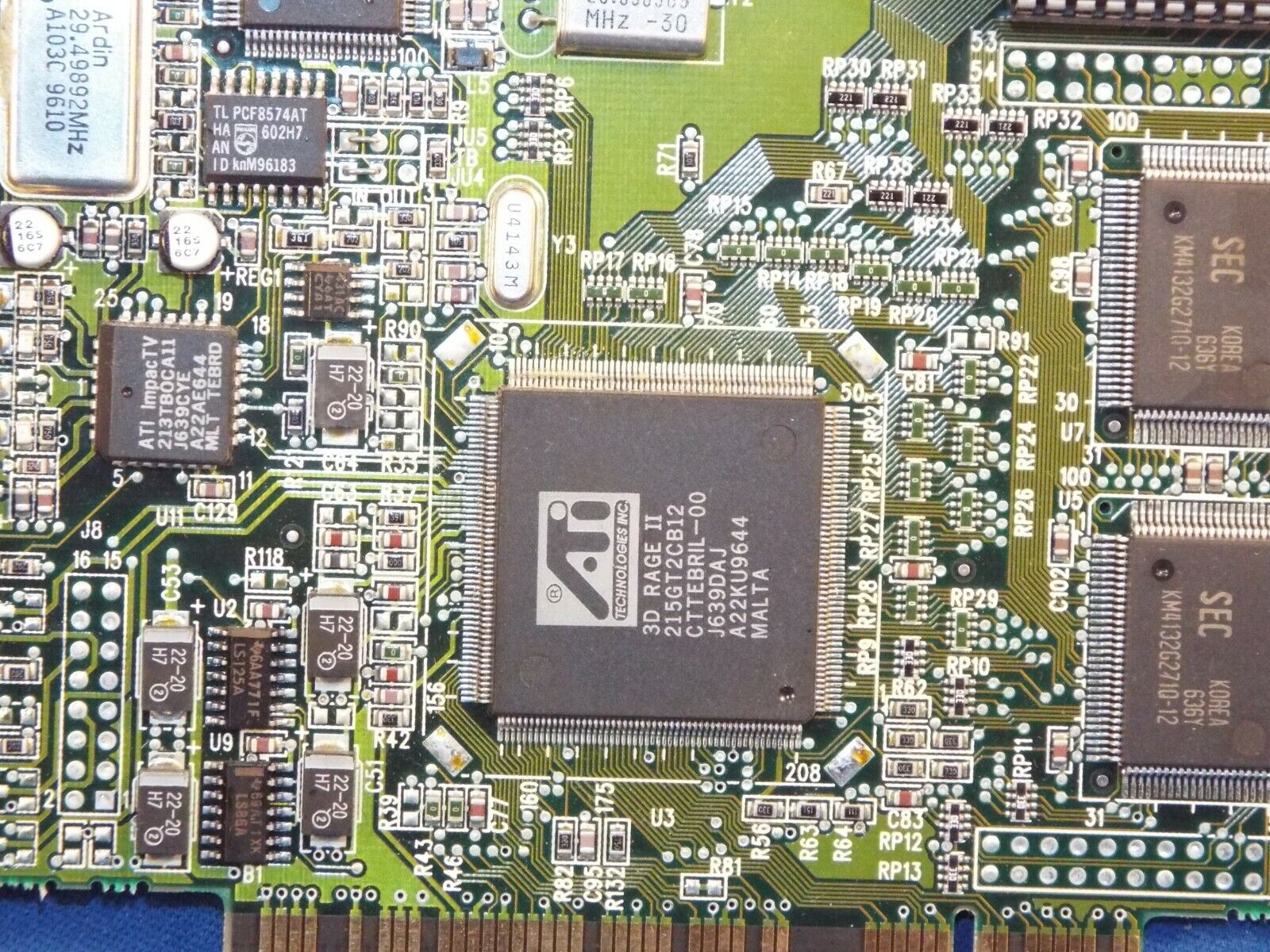 |
| Model and Part #: ATi 3D Xclaim, 109-37100-00 Main Chip: 3D Rage II, dated Week 44, 1996 RAM: 4 MB SGRAM (4 x Samsung KM4132G271 100-pin QFP, 83 MHz) BIOS Chip: 28-pin DIP "PCI mach64-VR 113-37101-114" This ATI 3D Xclaim from 1996 has solder pads only for memory expansion. It has a 15-pin DSUB for video out, plus TV-out and S-Video in ports. |
Rage II 2 MB card (109-38200-00) (1996):
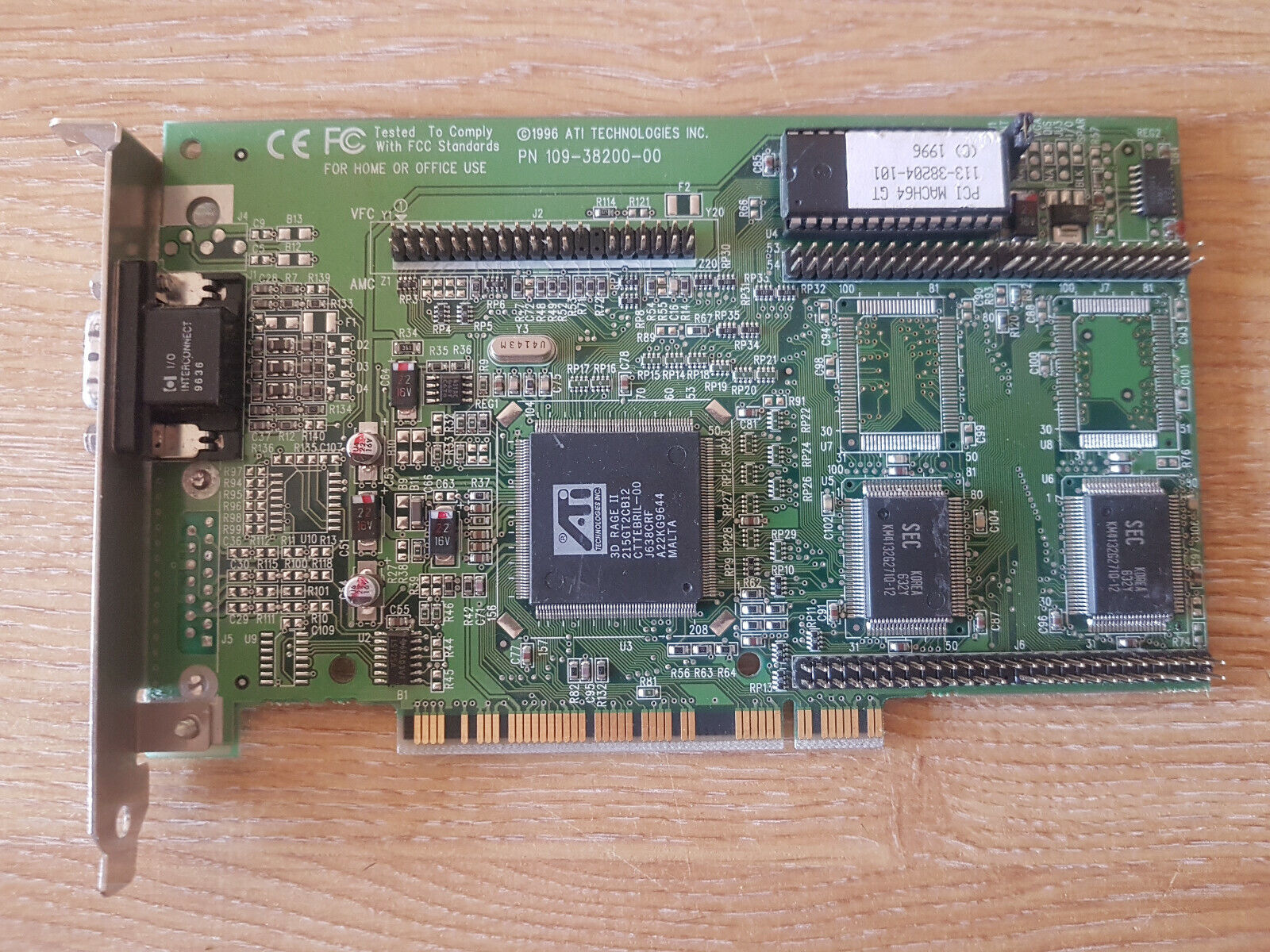 |
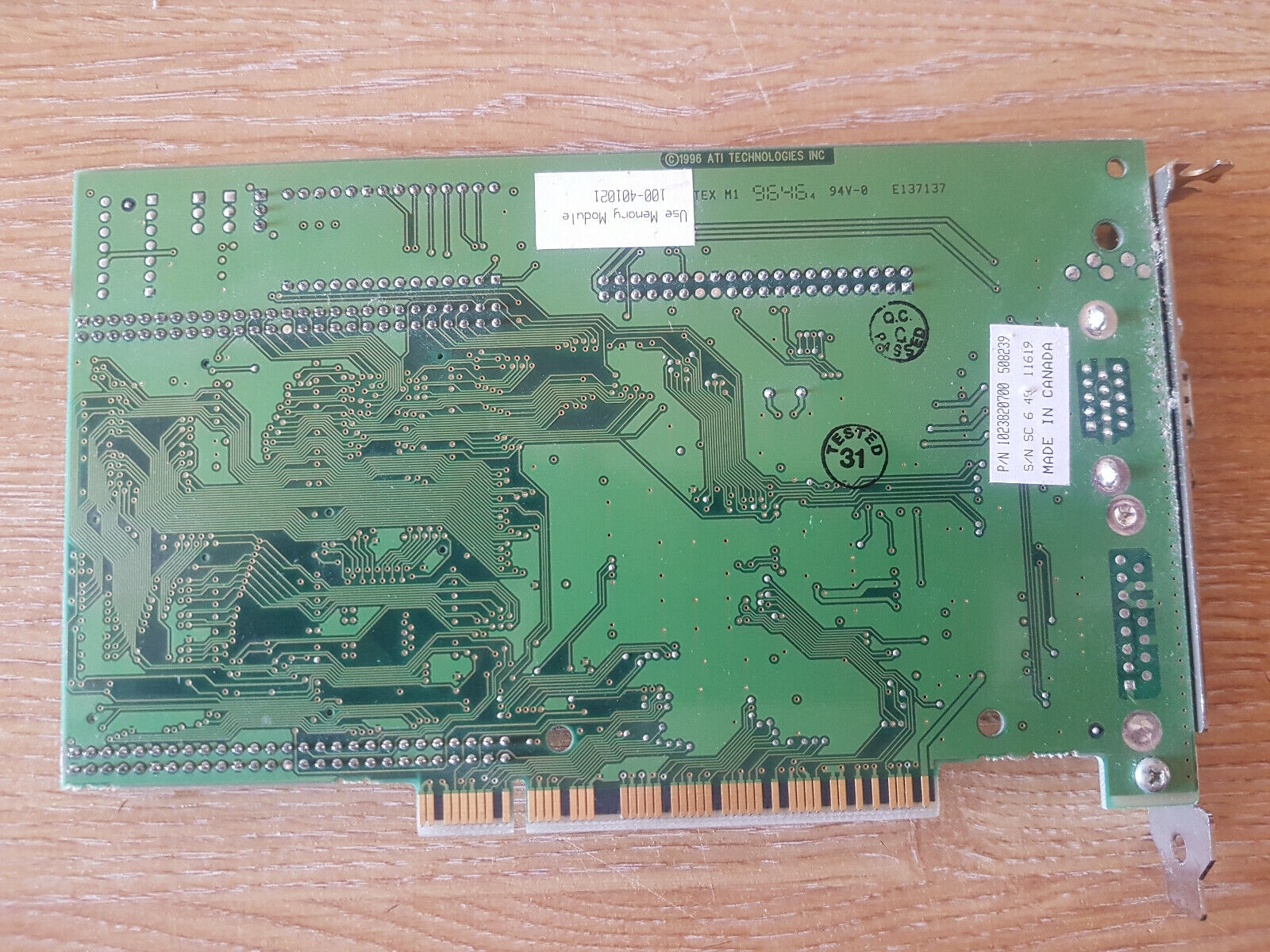 |
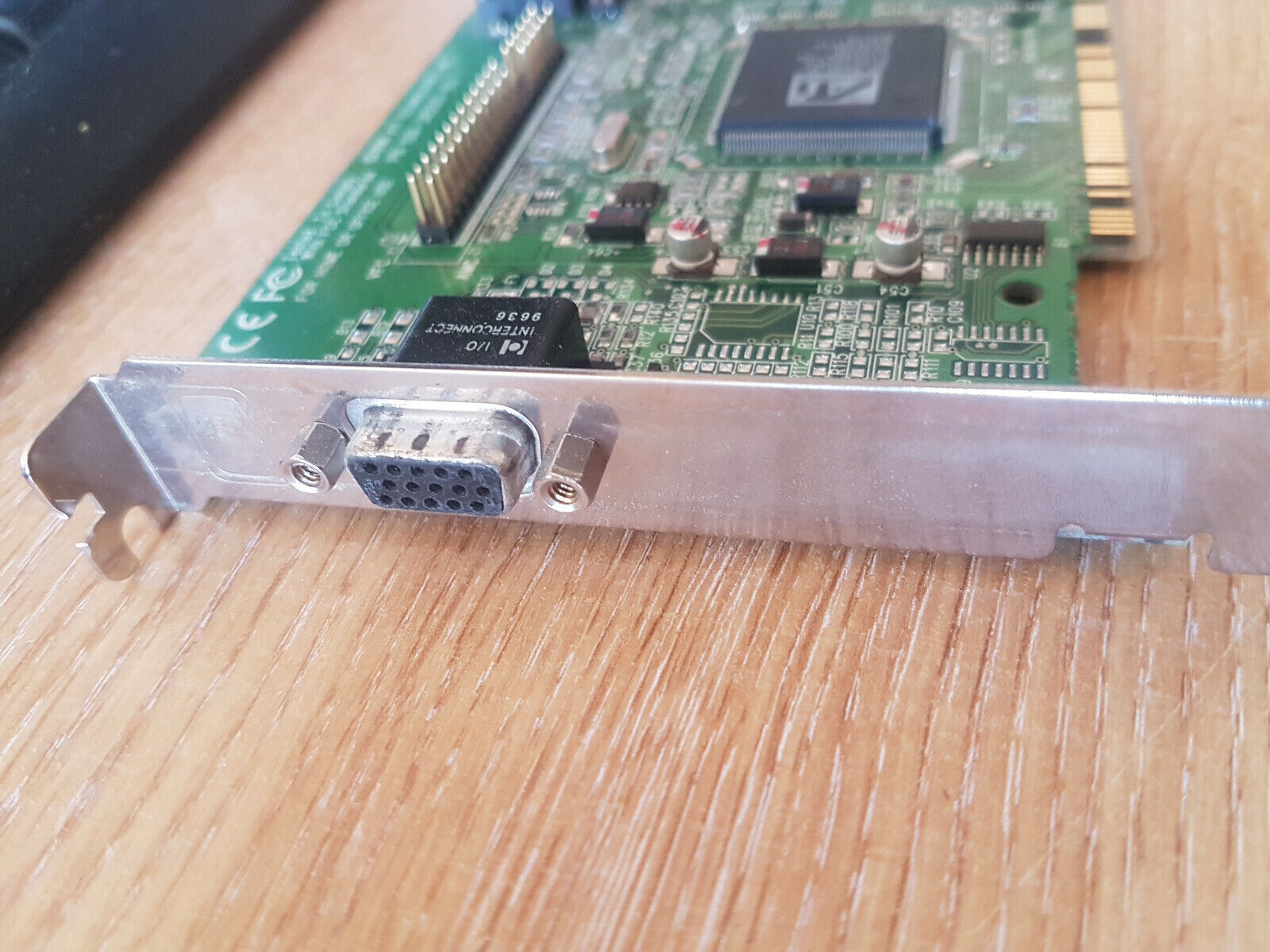 |
Model and Part #: 3D Xpression+, 109-38200-00 Main Chip: 3D Rage II, dated Week 44, 1996 RAM: 2 MB SGRAM (2 x Samsung KM4132G271 100-pin QFP, 83 MHz) BIOS Chip: 28-pin DIP "PCI MACH64 GT 113-38204-101" This ATI 3D Xpression+ card from 1996 has memory expansion headers. It has only the 15-pin DSUB for video out. |
Rage II 4 MB card (109-38500-00) (1996):
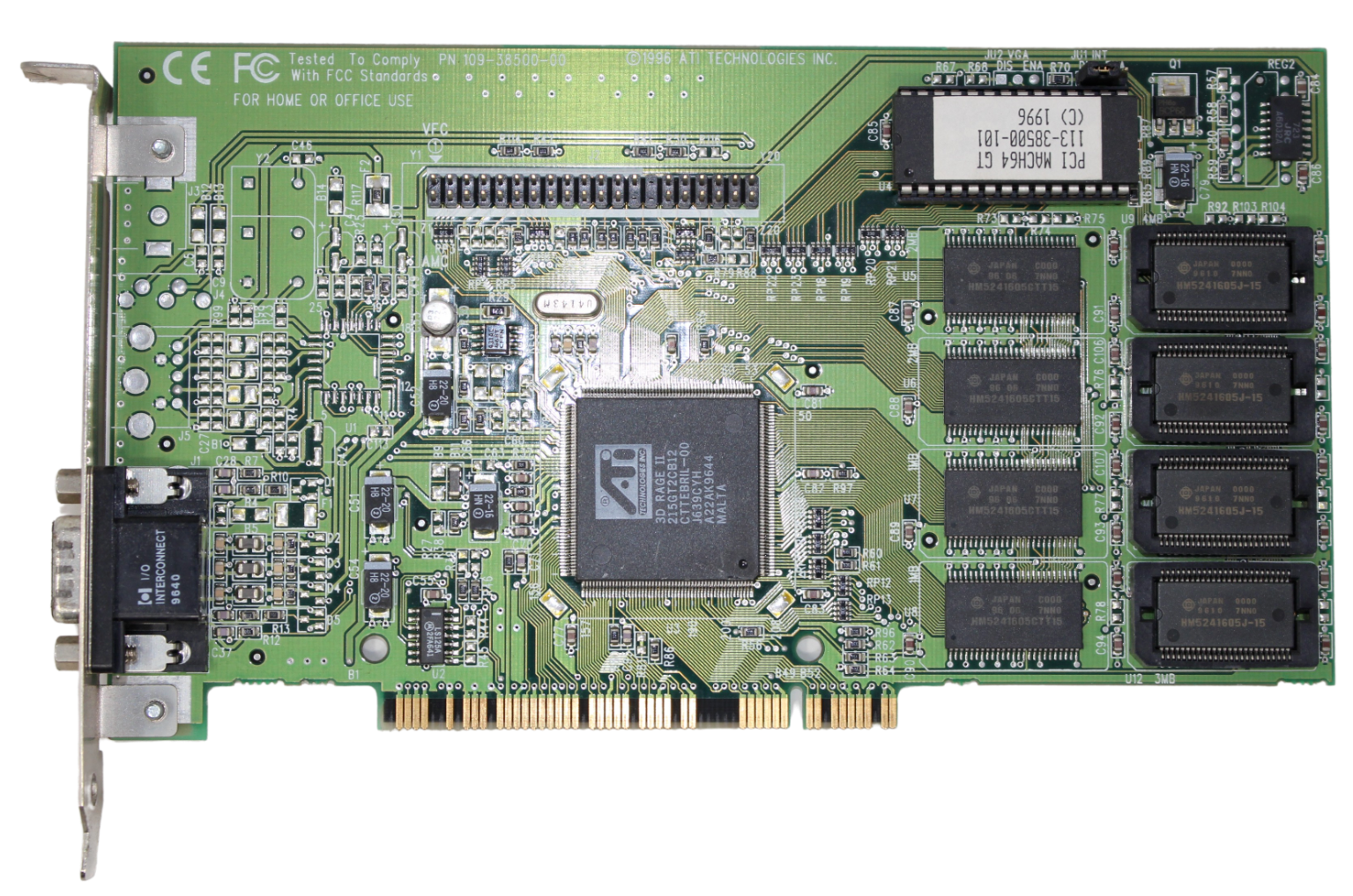 |
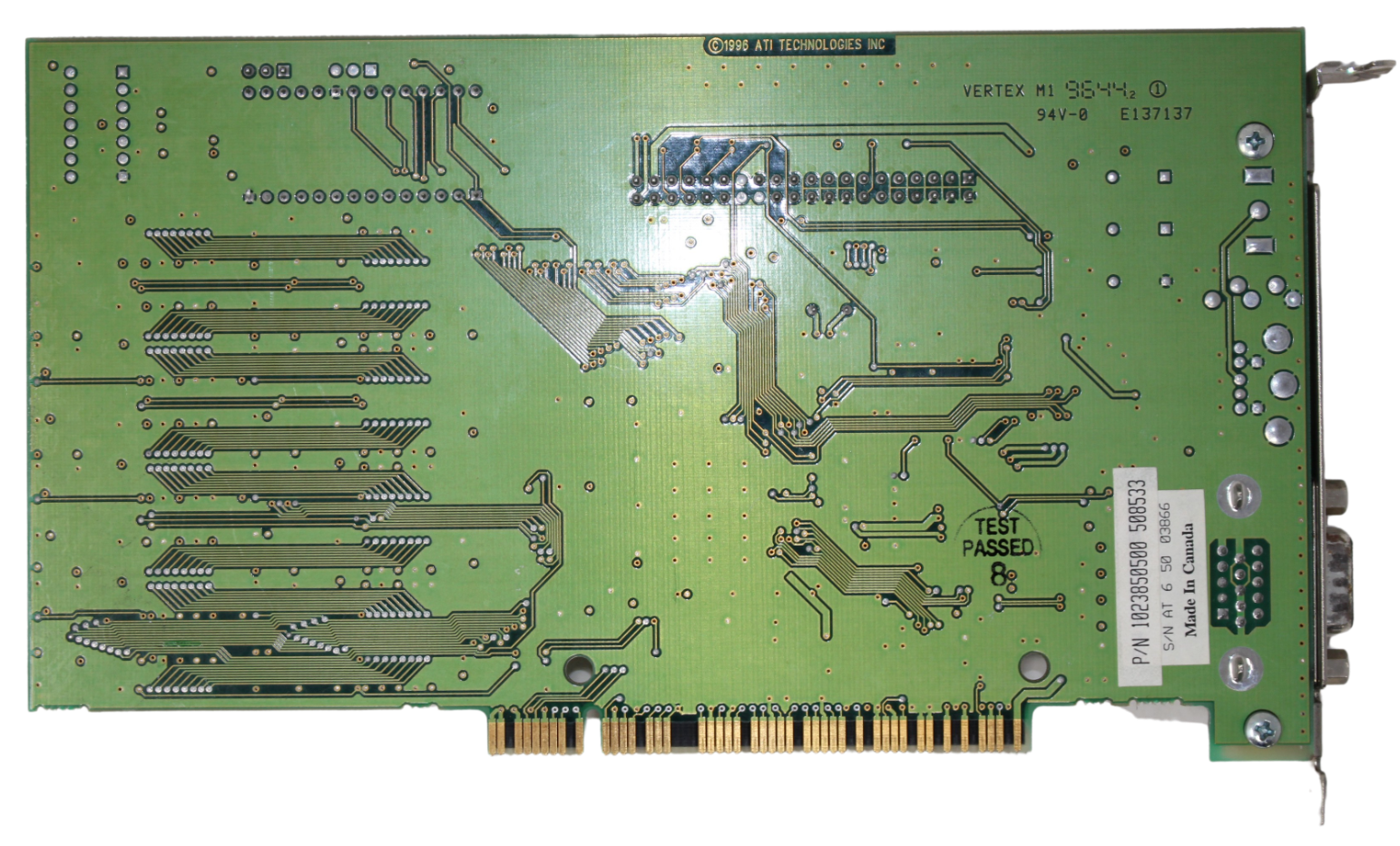 |
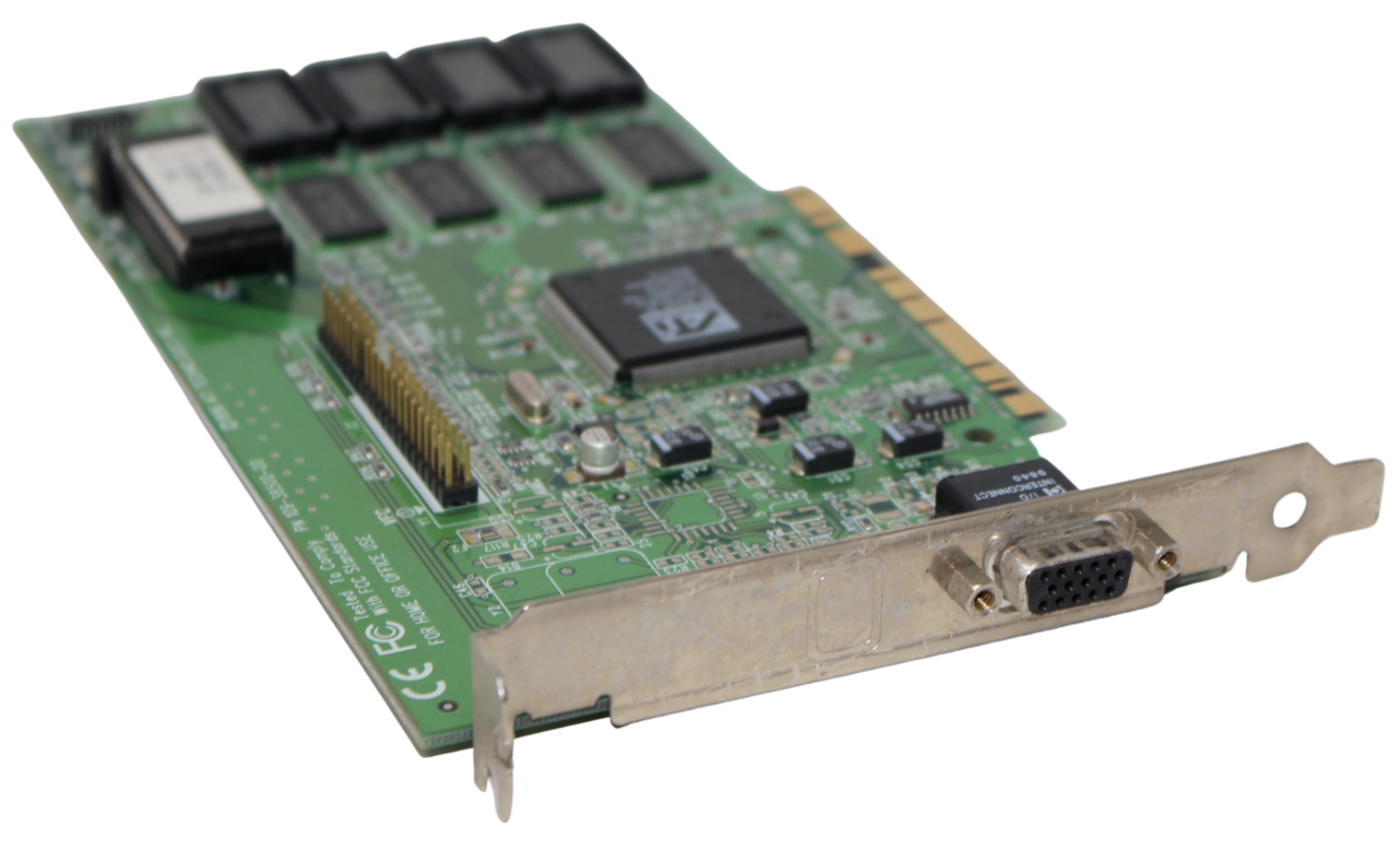 |
Model and Part #: 3D Xpression+PC2TV, 109-38200-00 Main Chip: 3D Rage II, dated Week 44, 1996 RAM: 4 MB SDRAM (8 x Hitachi HM5241605-15 SOJ, 66 MHz) BIOS Chip: 28-pin DIP "PCI MACH64 GT 113-38500-101" This ATI 3D Xpression+ PC2TV card from 1996 has memory expansion via 4 additional SOJ sockets (populated on this card). It has only the 15-pin DSUB for video out. |
Rage II+DVD 4 MB card (109-38600-00) (1996):
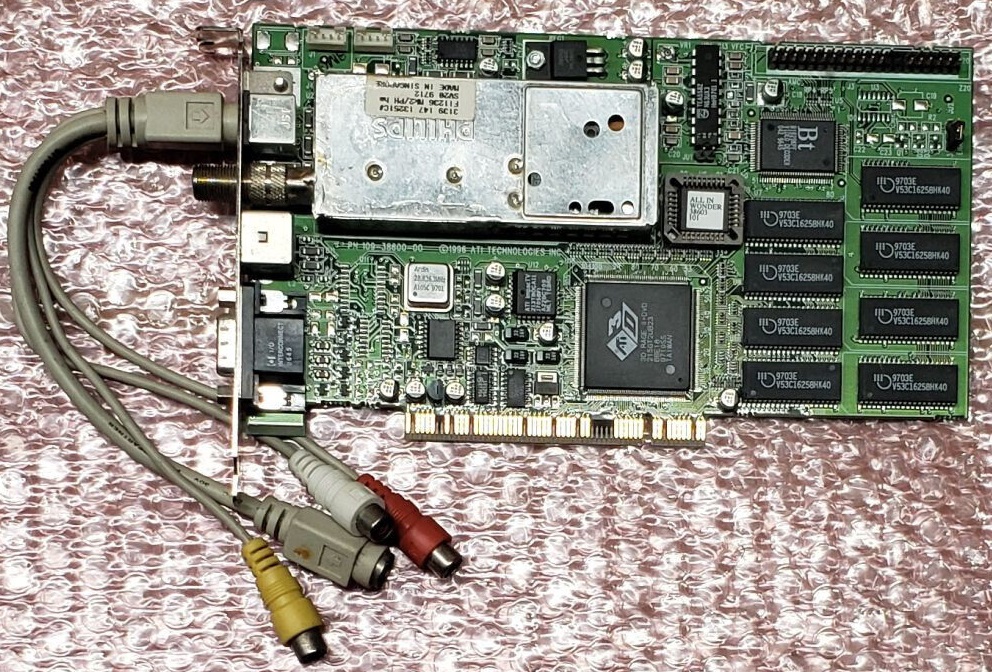 |
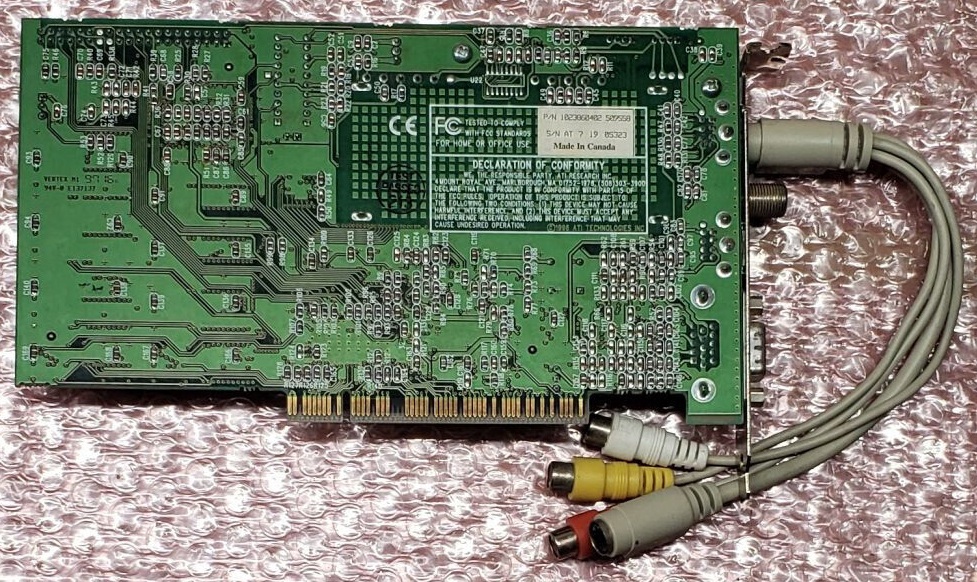 |
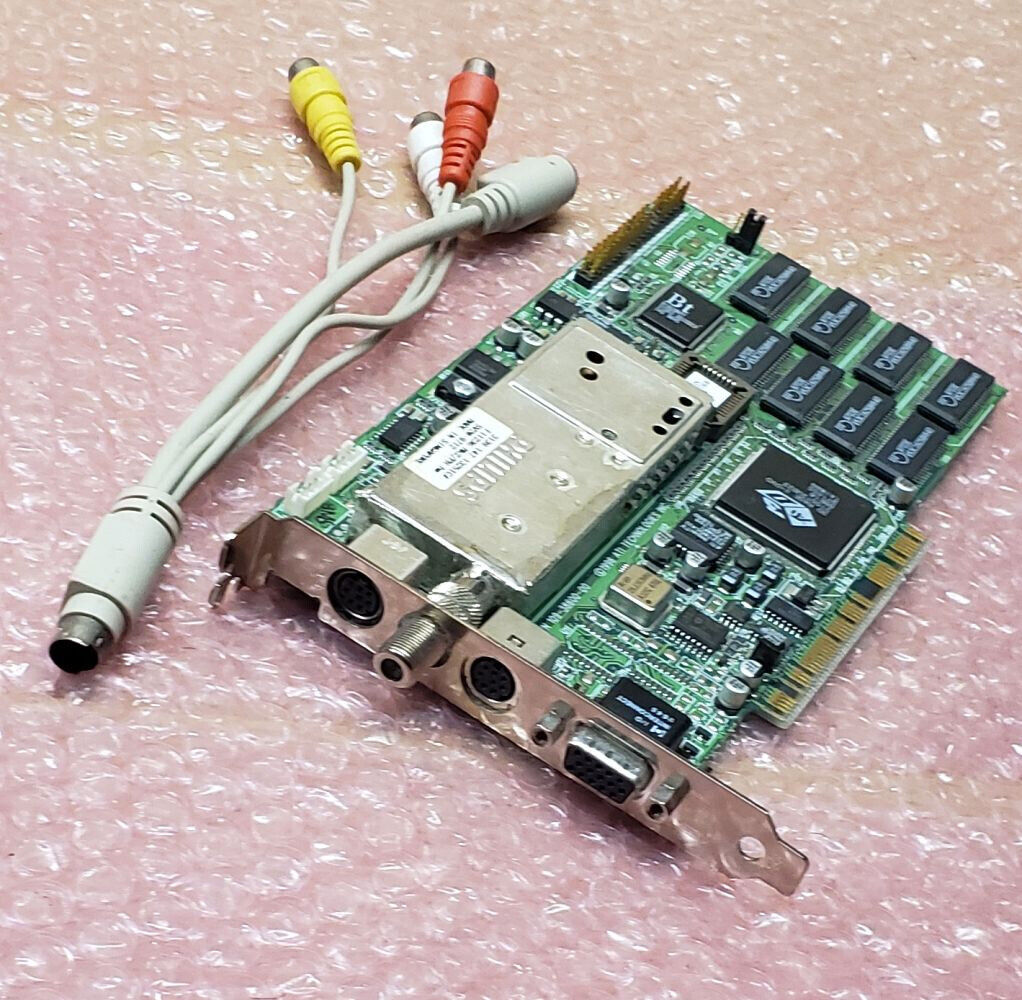 |
Model and Part #: ATI All-in-Wonder, 109-38600-00 Main Chip: 3D Rage II+DVD, dated Week 10, 1997 RAM: 4 MB EDO (8 x Mosel-Vitelic V53C16258HK 40-pin SOJ 40ns) BIOS Chip: 36-pin PLCC "ALL IN WONDER 38601 101" This ATI All in Wonder card from 1996 has no memory expansion headers. Being an All-in-Wonder though, it does have the TV tuner module and the ImpacTV chip, and on the backplate you get the S-video and composite in ports, plus S-Video and TV-out (coax?) out in addition to the standard 15-pin DSUB for SVGA video out. |
Rage II+DVD 2 MB card (109-38800-00) (1996):
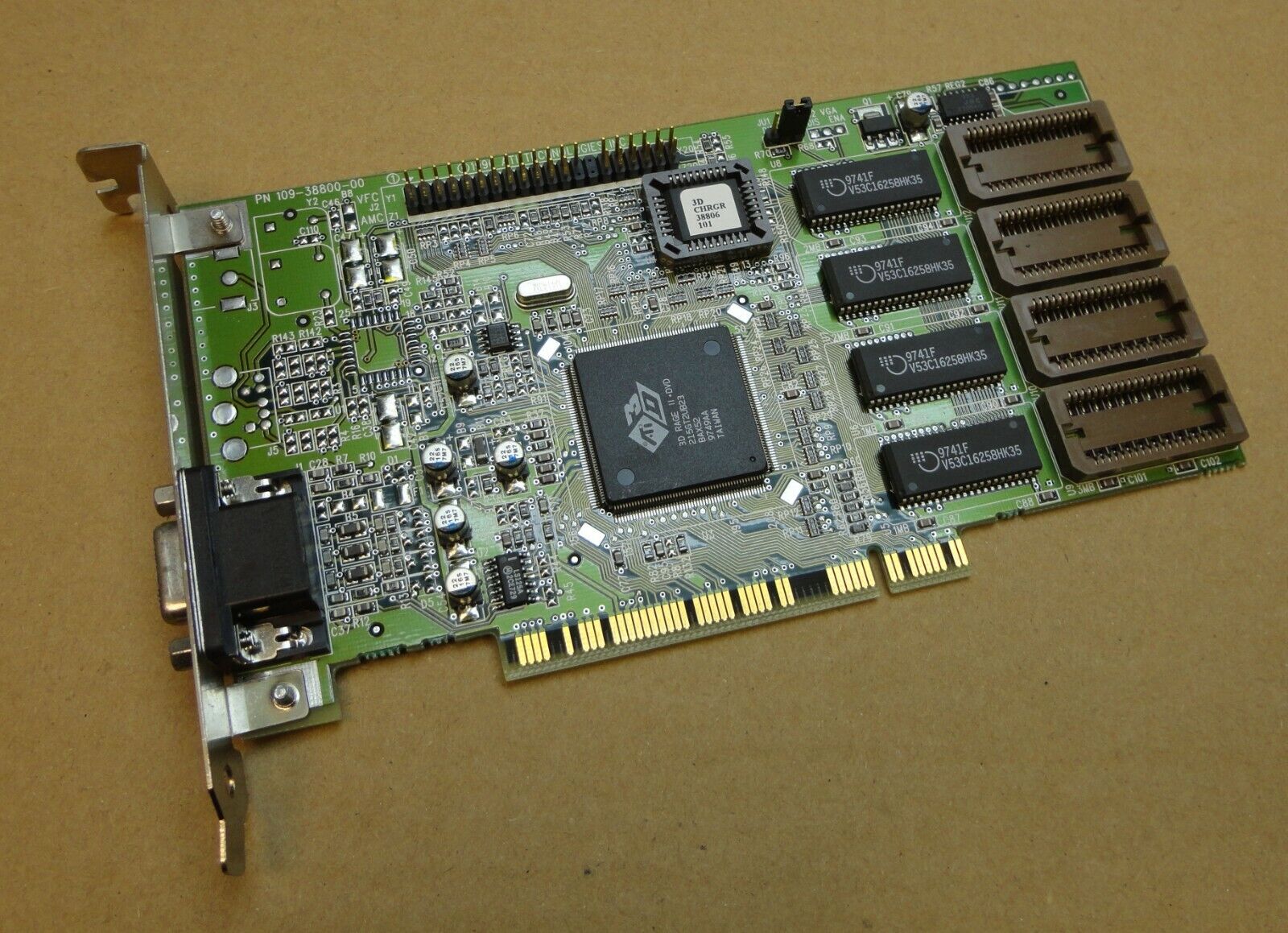 |
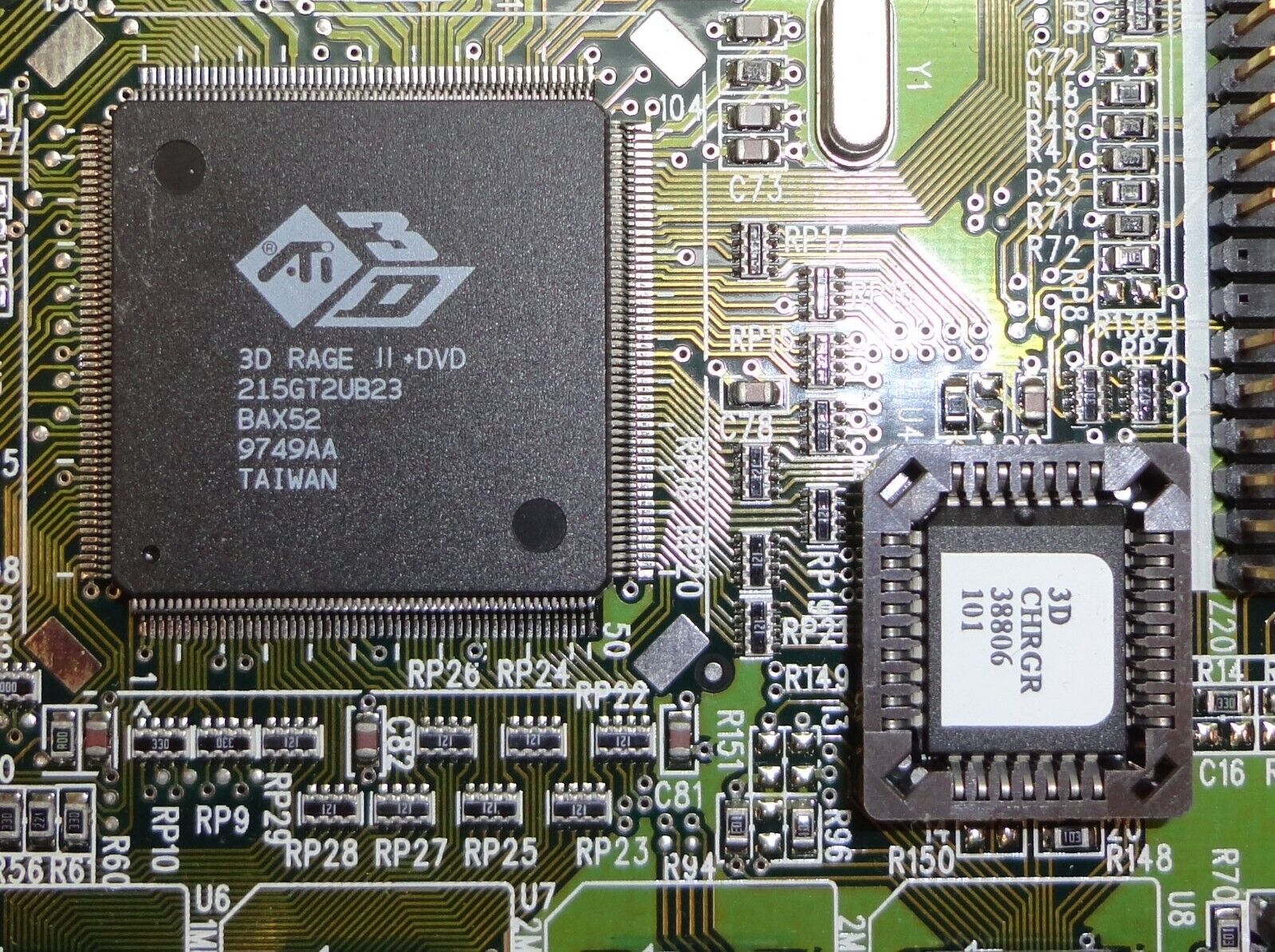 |
 |
Model and Part #: ATi 3D Charger, 109-38800-00 Main Chip: 3D Rage II+DVD, dated Week 49, 1997 RAM: 2 MB EDO (4 x Mosel-Vitelic V53C16258HK 40-pin SOJ 35ns) BIOS Chip: 36-pin PLCC "3D CHRGR 38806 101" This ATI 3D Charger card from 1996 has available SOJ sockets for 4 EDO memory chips. It has only the 15-pin DSUB for video out. |
Rage II+DVD 4 MB card (109-38800-00) (1996):
Rage II+DVD 4 MB card (109-38800-20) (1998):
Rage II+DVD 2 MB card (109-40100-00) (1996):
Rage II+DVD 4 MB card (109-40100-00) (1996):
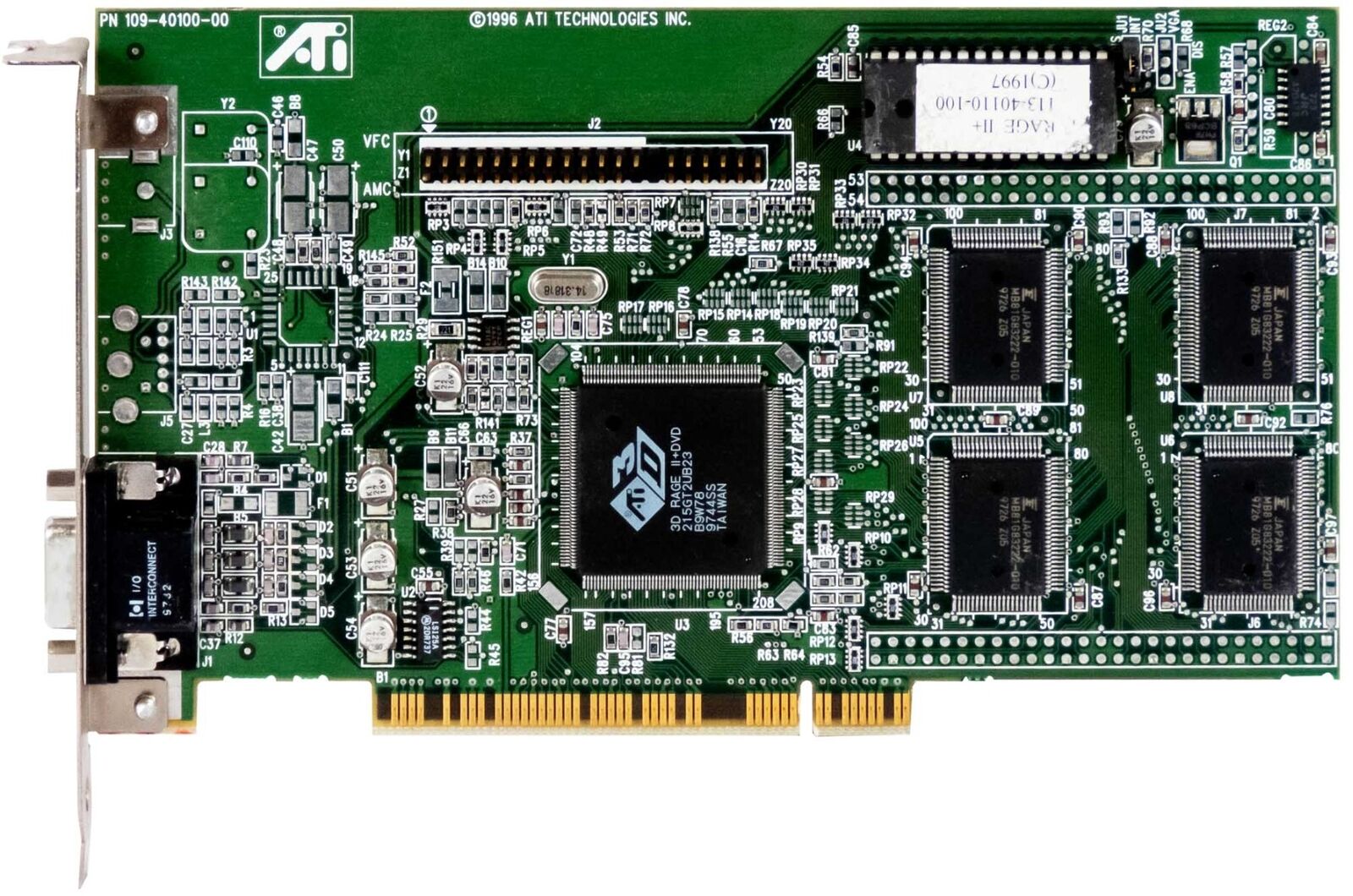 |
Model and Part #: ATI 3D Rage II, 109-40100-00 Main Chip: 3D Rage II+DVD, dated Week 44, 1997 RAM: 4 MB SGRAM (4 x Fujitsu MB81G83222 PQFP, 100 MHz) BIOS Chip: 28-pin DIP "RAGE II+ 113-40110-100" This ATI 3D Rage II card from 1997 has no memory expansion headers but does have solder pads for them. It has only the 15-pin DSUB for video out. |
Rage II+DVD 2 MB card (109-40600-00) (1997):
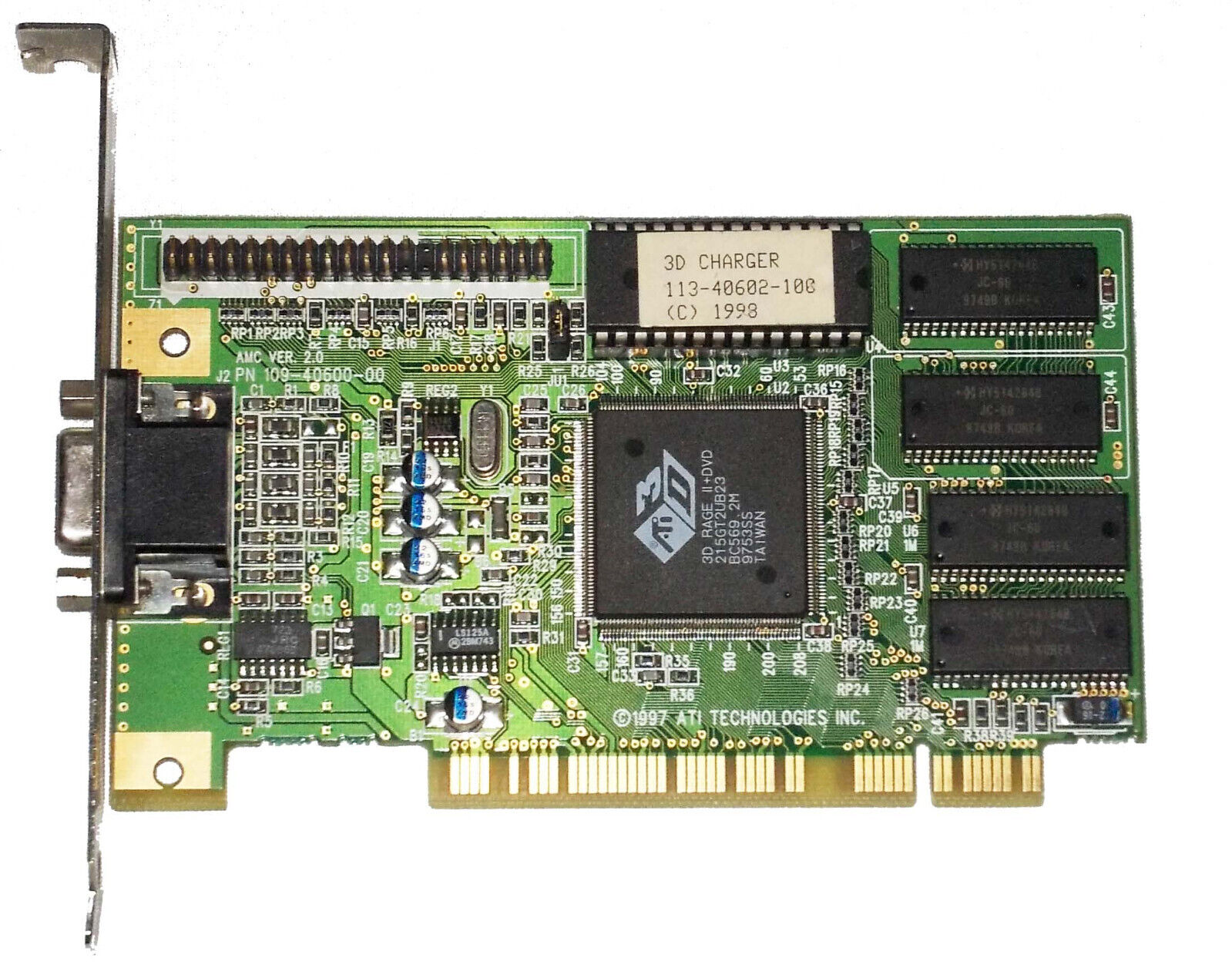 |
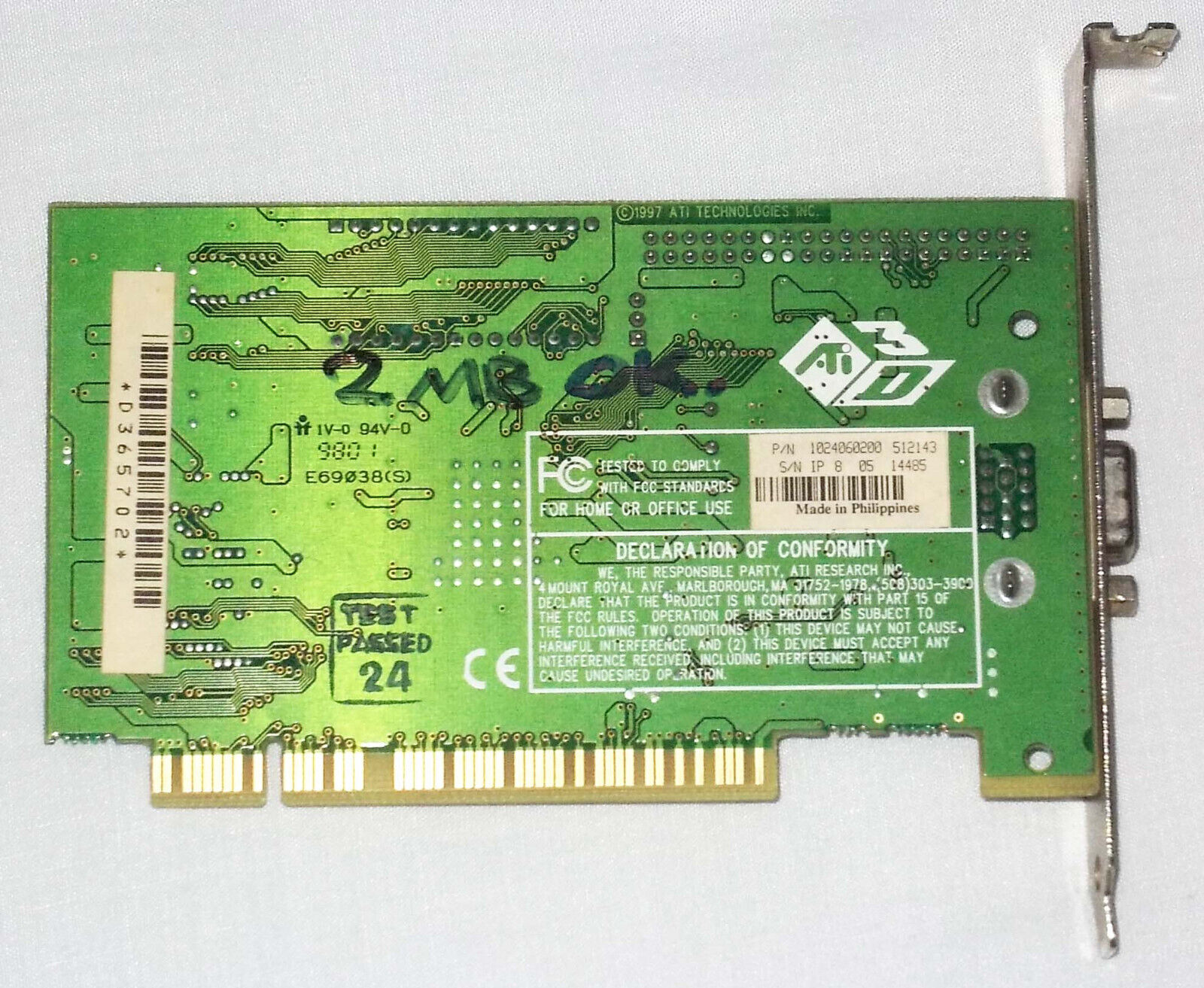 |
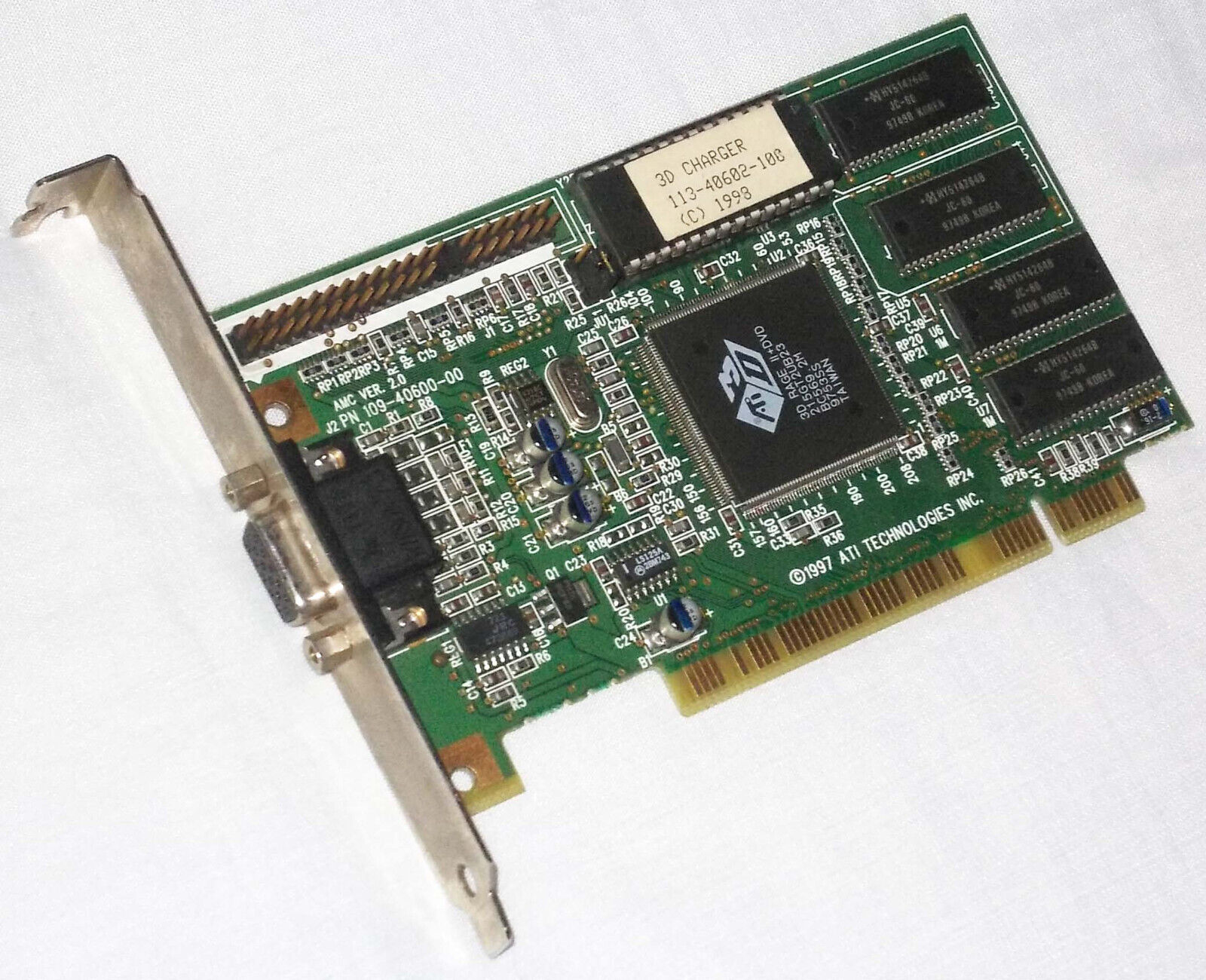 |
Model and Part #: ATI 3D Rage IIC PCI, 109-40600-00 Main Chip: 3D Rage II+DVD, dated Week 53, 1997 RAM: 2 MB EDO (4 x 40-pin Hyundai HY514264B 60ns SOJ) BIOS Chip: 28-pin DIP "3D CHARGER 113-40602-100" This ATI 3D Rage IIC PCI card from 1997 has memory expansion headers. It has only the 15-pin DSUB for video out. |
ATI-264VT4 4 MB card (109-40600-10) (1998):
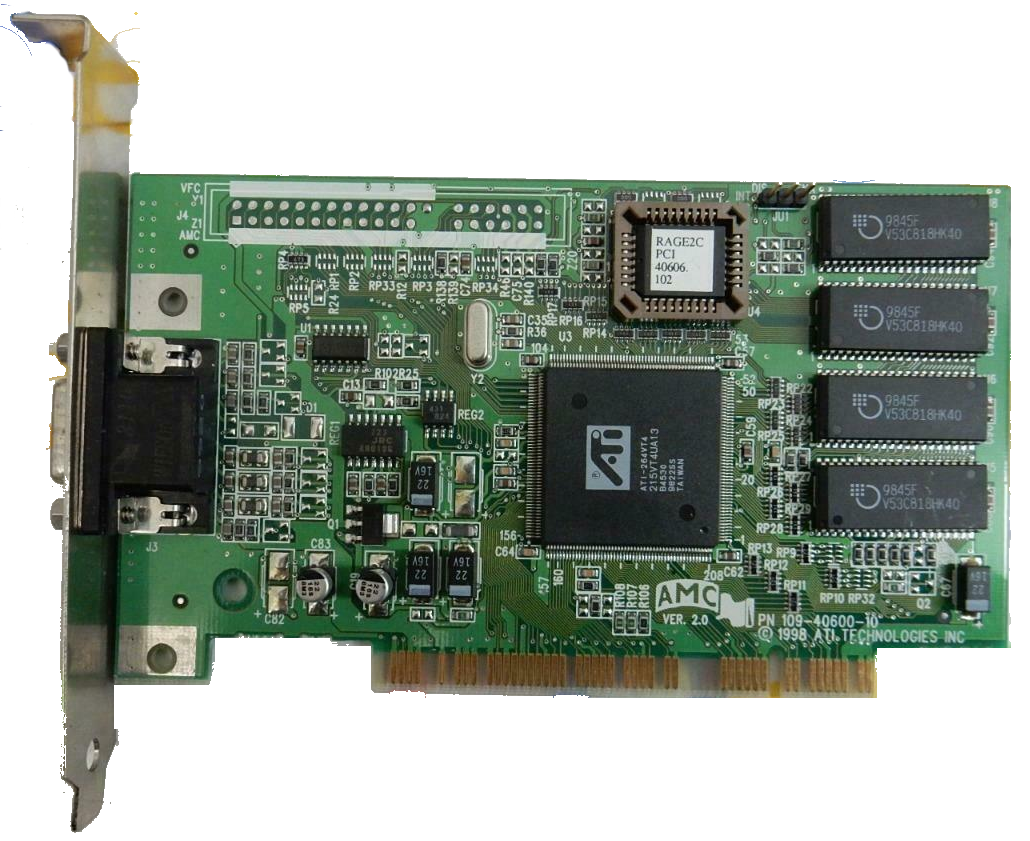 |
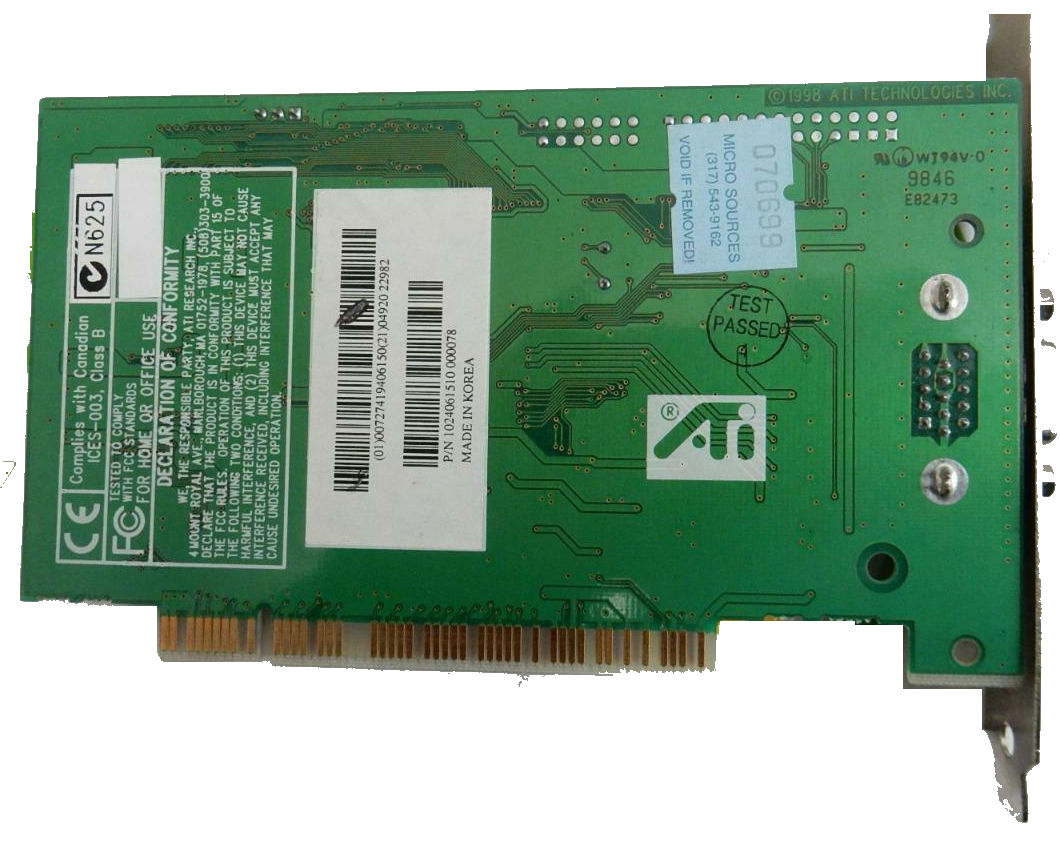 |
| Model and Part #: ATI 3D Rage IIC PCI, 109-40600-10 Main Chip: ATI-264VT4, dated Week 22, 1998 RAM: 4 MB EDO (4 x 40-pin Mosel-Vitelic V53C818HK 40ns SOJ) BIOS Chip: 36-pin PLCC "RAGE2C PCI 40606.102" This ATI 3D Rage IIC PCI card from 1998 has no memory expansion headers, and unlike most cards here, only has solder pads for the AMC interface. It has only the 15-pin DSUB for video out. |
Rage IIc 4 MB card (109-48300-00) (1998):
Downloads
After installing the ATI version 5.21 or 5.24 driver into Windows 98, certain fonts may appear blocky/corrupt. Occurs most frequently with higher colour depths (16-32 bpp). To work around the problem, disable Win98 "Font Smoothing" (Control Panel -> Display Properties -> Effects -> Smooth edge of screen fonts).
The 3D Rage II series were pin-compatible with the original 3D Rage, and all had the ATi mach64 2D core, so most drivers for mach64 will also work with 3D Rage II cards.
For AGP cards, Windows NT 4.0 drivers require Service Pack 3 to be installed.
Click on an icon in the table below to download the fille.
Windows 3.1 and 3.11 Drivers For All-in-Wonder,
3D Pro Turbo, 3D Pro Turbo PC2TV,
3D Xpression+, 3D Xpression+ PC2TV,
3D Charger, |
DOS & Windows 3.11 Drivers For ATi Mach64. |
Windows 95 Driver For ATi Mach64. |
Windows 95 Drivers Rev 4.10.2278 For Rage Pro, Rage II, II+ and mach64-VT products in Windows 95 only. |
Windows 98/ME Driver Pack Rev 4.10.2420, 30th Jul 1998 For Rage II and Rage II+DVD. |
Windows 9x Drivers v5.24 Rev 4.11.2440, 18th Dec 1998 For Rage IIC.
File: w82440en.exe |
Windows 98/ME Driver PackRev 4.11.2474, 18th Dec 1998 For Rage IIC. |
Windows 95 Driver Enhanced display driver for ATi Mach64. |
Windows 9x/ME/NT/2000 DriversRev 5.30 OEM (HP) driver for Rage IIC. Works for both PCI and AGP cards. |
Windows NT Driver For Rage IIC and 3D Charger. |
Windows 95/98 & NT 4.0 Driver For Rage II, Rage II+, Rage IIC. |
Windows 95/98 & NT 4.0 Driver For Rage II, Rage II+, Rage IIC, and Rage LT/LT Pro. PCI and AGP. |
OS/2 2.11 & Warp 3+ Drivers Drivers for OS/2 v2.11, Warp 3 and above. For all mach64 and Rage cards including Rage IIC. |
OS/2 2.11 & Warp Drivers For all mach64 and Rage cards including Rage IIC. |
OS/2 2.1 & Warp Drivers For all mach64 and Rage cards. |
OS/2 2.11 and Warp 3 Drivers OS/2 2.11 and Warp 3 and later display driver for ATI Rage Pro - should work on all Rage cards. |
OS/2 Warp 3 Drivers OS/2 Warp 3 and later display driver for ATI Rage LT Pro (LCD), Rage Pro, Rage IIC, Rage II/II+, Rage and VT. |
|
ATI Mach64 Driver CD Includes drivers for Windows 3.1, Windows 95, and OS/2 |
All-in-Wonder CD-ROM The original CD that came bundled with the AIW card. Includes drivers plus Macromedia Director and MGI Photosuite SE. (Games not included for copyright reasons) |
3D Xpression+ PC2TV Drivers Driver CD for the 3D Xpression+PC2TV card. Includes drivers for Windows 3.1, 95, NT. |

